Paul van Yperen's Blog, page 295
September 24, 2017
Jetta Goudal
Every year in early autumn, the Dutch film industry and public gather at the Netherlands Film Festival (NFF). Also this year, EFSP presents its own Unofficial Netherlands Film Star Postcards Festival from 20 to 29 September. Today, a temperamental Hollywood star who was born in the heart of old Amsterdam as Jetje Goudeket. She became successful as the exotic beauty Jetta Goudal (1891-1985) in American films of the silent era. In 1984, Life Magazine called her “the most alluring femme fatale in silent movies, also the smartest, best dressed and feistiest.”

French postcard.
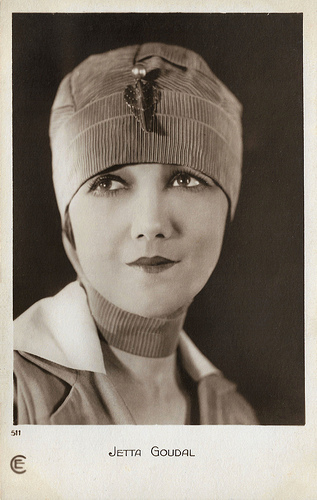
French postcard by Cinémagazine-Édition, Paris, no. 511.
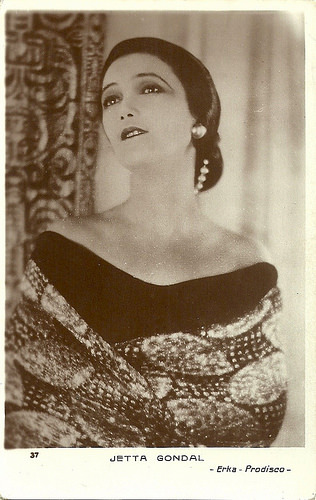
French postcard, no. 37. Photo: Erka-Prodisco. Erka-Prodisco Films was a French film distribution company. Her name is erroneously written as Jetta Gondal.
A Parisienne from Versailles
Jetta Goudal was born Julie Henriette Goudeket in 1891. She was the daughter of Mozes Goudeket, a wealthy, orthodox Jewish diamond cutter in the Jordaan neighborhood of Amsterdam, and Geertruida Warradijn. Decades later, during World War II, her father and his second wife would be murdered in the concentration camp of Sobibor.
Tall and regal in appearance, Julie began her acting career on stage, traveling across Europe with various theater companies. In 1917 or 1918 (the sources differ about the date), Julie Goudeket left a Europe, ravaged by World War I to settle in New York City.
There she hid her Dutch and Jewish ancestry; she generally described herself as a ‘Parisienne’ and on an information sheet for the Paramount Public Department she later wrote that she was born at Versailles in 1901 as the daughter of Maurice Guillaume Goudal, a lawyer.
Her publicist at one point even claimed that she was the daughter of legendary Dutch spy Mata Hari, but no one took that statement seriously, though. Goudal first appeared on Broadway in the drama The Hero by Gilbert Emery in 1921, using the stage name Jetta (pronounced with a French J) Goudal. Later that year she returned with the melodrama The Elton Charm.
She met film director Sidney Olcott in a box at Carnegie Hall, who encouraged her to venture into film acting. She accepted a bit part in his film Timothy's Quest (Sidney Olcott, 1922) as a tubercular mother with children, in a pathetic scene with a drunken husband. Convinced to move to the West Coast, Goudal appeared in two more Olcott films in the ensuing three years.
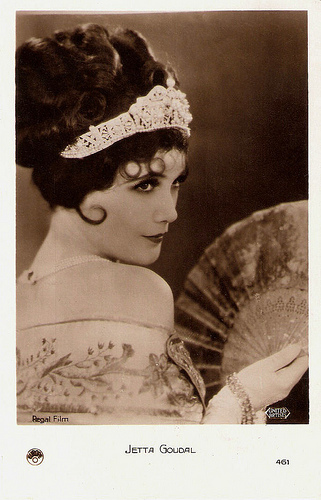
French postcard by Europe, no. 461. Photo: Regal Film / United Artists.
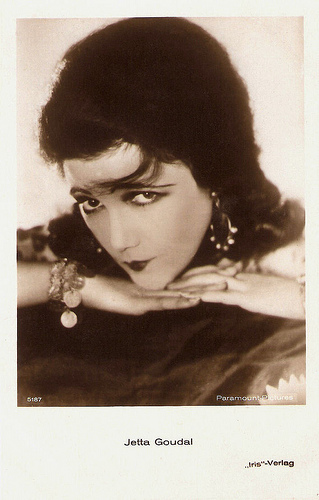
Austrian postcard by Iris-Verlag, no. 5187. Photo: Paramount.

British postcard in the Picturegoer Series, London, no. 273.
Different and Distinctive
Jetta Goudal's real film debut came in The Bright Shawl (John S. Robertson, 1923) with Richard Barthelmess. Jetta created quite a stir with her striking, exotic appearance in a secondary role as a Chinese/Peruvian spy. Critics found her "different" and "distinctive."
She quickly earned more praise for her following film work, especially for her performance in Salome of the Tenements (Sidney Olcott, 1925), a film based on the Anzia Yezierska novel about life in New York's Jewish Lower East Side.
Goudal then worked in the Adolph Zukor and Jesse L. Lasky co-production of The Spaniard (Raoul Walsh, 1925) opposite Ricardo Cortez – ‘the new Sheik’- in his first starring role.
Her growing fame brought her to the attention of producer/director Cecil B. DeMille. He hired her for what turned out to be some of her (and his) greatest critical successes, including her emotional roles in the highly romantic melodrama The Coming of Amos (Paul Sloane, 1925) starring Rod LaRocque, The Road to Yesterday (Cecil B. DeMille, 1925), the excellent mystery melodrama Three Faces East (Rupert Julian, 1926), the extremely powerful drama White Gold (William K. Howard, 1927) and the lush desert romantic melodrama The Forbidden Woman (Paul L. Stein, 1927) with Victor Varconi .
Unfortunately, the exotic allure and element of mystery that made Goudal so popular on-screen came with a price. She was an unrepentant theatrical ‘grand dame’ and possessed a fierce temper well known to the film community. DeMille later claimed that Goudal was so difficult to work with that he eventually fired her and cancelled their contract.
Goudal filed a lawsuit for breach of contract against him and DeMille Pictures Corporation. Although DeMille claimed her conduct had caused numerous and costly production delays, in a landmark ruling, Goudal won the suit when DeMille was unwilling to provide his studio's financial records to support his claim of financial losses.

British postcard by Real Photograph.
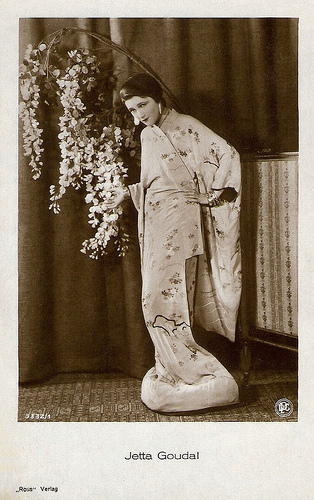
German postcard by Ross Verlag, no. 3332/1, 1928-1929. Photo: DPC.

German postcard by Ross Verlag, no. 1475/1, 1927-1928. Photo: DPC.
Vamp or Joan of Arc?
Jetta Goudal appeared as a vamp opposite Marion Davies and Nils Asther in The Cardboard Lover (Robert Z. Leonard, 1928), produced by William Randolph Hearst and Marion Davies .
In 1929, she starred with Lupe Velez and cowboy star William Boyd in Lady of the Pavements (D.W. Griffith, 1929), a romantic drama set in the time of Napoleon in Paris. At IMDb , reviewer Drednm loves it: "While William Boyd hasn't much to do here as the Count, the two leading ladies tear the place apart. Fiery Lupe Velez is superb as Nanon, taking full advantage of the comic scenes but then turning in a terrific dramatic performance in the finale. Jetta Goudal is gorgeous and lethal as Diane, using her haughty beauty to good effect."
The next year Jacques Feyder directed Goudal in her only French language film, Le Spectre vert/The Green Spectre (Jacques Feyder, 1930), a made-in-Hollywood, alternate language version of The Unholy Night (1929).
Because of her audaciousness in suing DeMille and her high-profile activism in the Actors Equity's fight for the unionisation of film actors she became known as the Joan of Arc of Equity. However, some of the Hollywood studios refused to employ her and with the arrival of sound her very thick accent left her with limited offers.
At age forty-one, she made her last screen appearance in a talkie, the comedy Business and Pleasure (David Butler, 1932), co-starring with Will Rogers. In 1930, she had married Harold Grieve, an art director and founding member of the Academy of Motion Picture Arts and Sciences. Along with her husband, she went into interior design and faded from the Hollywood scene. They had no children.
Plagued by health problems (heart condition) in the 1960s, she suffered a serious fall in 1973 which left her virtually an invalid. She told an interviewer in 1985: "I don't like being called a silent star. Who was silent? I was never silent!"
Shortly after, Jetta Goudal died in 1985 in Los Angeles, at age 94. For her contribution to the film industry, she has a star on the Hollywood Walk of Fame.

German postcard by Ross Verlag, no. 3332/2, 1928-1929. Photo: LPG.
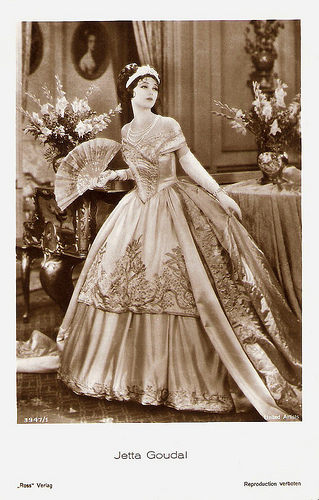
German postcard by Ross Verlag, no. 3947/1, 1928-1929. Photo: United Artists.
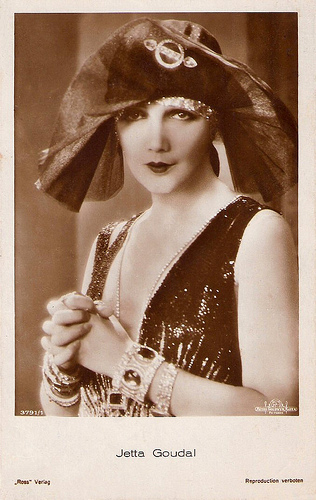
German postcard by Ross Verlag, no. 3791/1, 1928-1929. Photo: MGM (Metro Goldwyn Mayer).
Sources: Charles C. Benham (Classic Images), Hans J. Wollstein (AllMovie), Operator_99 (Allure), (IMDb), Wikipedia, and .

French postcard.

French postcard by Cinémagazine-Édition, Paris, no. 511.

French postcard, no. 37. Photo: Erka-Prodisco. Erka-Prodisco Films was a French film distribution company. Her name is erroneously written as Jetta Gondal.
A Parisienne from Versailles
Jetta Goudal was born Julie Henriette Goudeket in 1891. She was the daughter of Mozes Goudeket, a wealthy, orthodox Jewish diamond cutter in the Jordaan neighborhood of Amsterdam, and Geertruida Warradijn. Decades later, during World War II, her father and his second wife would be murdered in the concentration camp of Sobibor.
Tall and regal in appearance, Julie began her acting career on stage, traveling across Europe with various theater companies. In 1917 or 1918 (the sources differ about the date), Julie Goudeket left a Europe, ravaged by World War I to settle in New York City.
There she hid her Dutch and Jewish ancestry; she generally described herself as a ‘Parisienne’ and on an information sheet for the Paramount Public Department she later wrote that she was born at Versailles in 1901 as the daughter of Maurice Guillaume Goudal, a lawyer.
Her publicist at one point even claimed that she was the daughter of legendary Dutch spy Mata Hari, but no one took that statement seriously, though. Goudal first appeared on Broadway in the drama The Hero by Gilbert Emery in 1921, using the stage name Jetta (pronounced with a French J) Goudal. Later that year she returned with the melodrama The Elton Charm.
She met film director Sidney Olcott in a box at Carnegie Hall, who encouraged her to venture into film acting. She accepted a bit part in his film Timothy's Quest (Sidney Olcott, 1922) as a tubercular mother with children, in a pathetic scene with a drunken husband. Convinced to move to the West Coast, Goudal appeared in two more Olcott films in the ensuing three years.

French postcard by Europe, no. 461. Photo: Regal Film / United Artists.

Austrian postcard by Iris-Verlag, no. 5187. Photo: Paramount.

British postcard in the Picturegoer Series, London, no. 273.
Different and Distinctive
Jetta Goudal's real film debut came in The Bright Shawl (John S. Robertson, 1923) with Richard Barthelmess. Jetta created quite a stir with her striking, exotic appearance in a secondary role as a Chinese/Peruvian spy. Critics found her "different" and "distinctive."
She quickly earned more praise for her following film work, especially for her performance in Salome of the Tenements (Sidney Olcott, 1925), a film based on the Anzia Yezierska novel about life in New York's Jewish Lower East Side.
Goudal then worked in the Adolph Zukor and Jesse L. Lasky co-production of The Spaniard (Raoul Walsh, 1925) opposite Ricardo Cortez – ‘the new Sheik’- in his first starring role.
Her growing fame brought her to the attention of producer/director Cecil B. DeMille. He hired her for what turned out to be some of her (and his) greatest critical successes, including her emotional roles in the highly romantic melodrama The Coming of Amos (Paul Sloane, 1925) starring Rod LaRocque, The Road to Yesterday (Cecil B. DeMille, 1925), the excellent mystery melodrama Three Faces East (Rupert Julian, 1926), the extremely powerful drama White Gold (William K. Howard, 1927) and the lush desert romantic melodrama The Forbidden Woman (Paul L. Stein, 1927) with Victor Varconi .
Unfortunately, the exotic allure and element of mystery that made Goudal so popular on-screen came with a price. She was an unrepentant theatrical ‘grand dame’ and possessed a fierce temper well known to the film community. DeMille later claimed that Goudal was so difficult to work with that he eventually fired her and cancelled their contract.
Goudal filed a lawsuit for breach of contract against him and DeMille Pictures Corporation. Although DeMille claimed her conduct had caused numerous and costly production delays, in a landmark ruling, Goudal won the suit when DeMille was unwilling to provide his studio's financial records to support his claim of financial losses.

British postcard by Real Photograph.

German postcard by Ross Verlag, no. 3332/1, 1928-1929. Photo: DPC.

German postcard by Ross Verlag, no. 1475/1, 1927-1928. Photo: DPC.
Vamp or Joan of Arc?
Jetta Goudal appeared as a vamp opposite Marion Davies and Nils Asther in The Cardboard Lover (Robert Z. Leonard, 1928), produced by William Randolph Hearst and Marion Davies .
In 1929, she starred with Lupe Velez and cowboy star William Boyd in Lady of the Pavements (D.W. Griffith, 1929), a romantic drama set in the time of Napoleon in Paris. At IMDb , reviewer Drednm loves it: "While William Boyd hasn't much to do here as the Count, the two leading ladies tear the place apart. Fiery Lupe Velez is superb as Nanon, taking full advantage of the comic scenes but then turning in a terrific dramatic performance in the finale. Jetta Goudal is gorgeous and lethal as Diane, using her haughty beauty to good effect."
The next year Jacques Feyder directed Goudal in her only French language film, Le Spectre vert/The Green Spectre (Jacques Feyder, 1930), a made-in-Hollywood, alternate language version of The Unholy Night (1929).
Because of her audaciousness in suing DeMille and her high-profile activism in the Actors Equity's fight for the unionisation of film actors she became known as the Joan of Arc of Equity. However, some of the Hollywood studios refused to employ her and with the arrival of sound her very thick accent left her with limited offers.
At age forty-one, she made her last screen appearance in a talkie, the comedy Business and Pleasure (David Butler, 1932), co-starring with Will Rogers. In 1930, she had married Harold Grieve, an art director and founding member of the Academy of Motion Picture Arts and Sciences. Along with her husband, she went into interior design and faded from the Hollywood scene. They had no children.
Plagued by health problems (heart condition) in the 1960s, she suffered a serious fall in 1973 which left her virtually an invalid. She told an interviewer in 1985: "I don't like being called a silent star. Who was silent? I was never silent!"
Shortly after, Jetta Goudal died in 1985 in Los Angeles, at age 94. For her contribution to the film industry, she has a star on the Hollywood Walk of Fame.

German postcard by Ross Verlag, no. 3332/2, 1928-1929. Photo: LPG.

German postcard by Ross Verlag, no. 3947/1, 1928-1929. Photo: United Artists.

German postcard by Ross Verlag, no. 3791/1, 1928-1929. Photo: MGM (Metro Goldwyn Mayer).
Sources: Charles C. Benham (Classic Images), Hans J. Wollstein (AllMovie), Operator_99 (Allure), (IMDb), Wikipedia, and .
Published on September 24, 2017 22:00
September 23, 2017
Coen Hissink
Every year in early autumn, the Dutch film industry and public gather at the Netherlands Film Festival (NFF). Also this year, EFSP presents its own Unofficial Netherlands Film Star Postcards Festival from 20 to 29 September. Coen Hissink (1878-1942) was a Dutch stage and screen actor who acted in many silent films by Theo Frenkel Sr. First in the Netherlands in such films as Levensschaduwen (1916), Het proces Begeer (1918) and Menschenwee (1921) and afterwards in Berlin in Alexandra (1922) and other films. He also played in various silent Hollandia films. In the 1930s he acted in Dutch sound films. Hissink died in concentration camp Neuengamme.
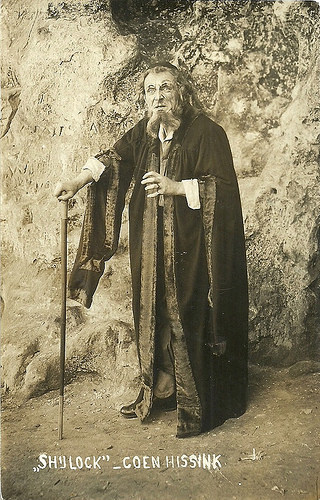
Dutch postcard. Coen Hissink as Shylock in The Merchant of Venice by William Shakespeare. This postcard may date c. 1907-1908 when Hissink played Shylock on the Dutch stage.
A Dutch Western
Johan Coenraad ‘Coen’ Hissink was born in 1878 in Kampen, The Netherlands.
After studying at the Toneelschool (Stage School) for a year, he began his acting career in the theatre in 1902. He made his stage debut in the Revue De Nieuwe Haring (The New Herring) and would have a long career on stage in both the Netherlands and Flanders.
He was also known as a writer. In 1910, he published the dissertation Louis Bouwmeester's Shylock-creatie. When legendary Dutch actor Louis Bouwmeester starred as Shylock in Shakespeare's play The Merchant of Venice - his most famous - Hissink sat in the stalls with pen and paper and recorded everything he saw and heard.
Hissink was best known for his stage work, both on and behind the stage. Together with Albert van Dalsum and Eugene Gilhuys, he founded the stage company Het Groot Toneel (The Big Stage) in the Plantage theater in Amsterdam. He also played many classic stage roles, such as Othello in 1918.
Hissink made his film debut in the Dutch Western (!) Een telegram uit Mexico/A Telegram from Mexico (Louis H. Chrispijn sr., 1914), a silent short film produced by Maurits Binger for his film studio Filmfabriek Hollandia. Hissink played the blind father of the Dutch colonist Willem (Willem van der Veer), who gets lost in the revolution in Mexico. The home front waits eagerly for news.
Next followed the silent drama De Vloek van het Testament/The Fatal Woman (Maurits Binger, Louis H. Chrispijn sr., 1915) starring Dutch diva Annie Bos . At the time, it was for the Netherlands a huge production with 48 copies through Europe and 12 copies crossing to America.
Hissink continued to appear in a stream of silent Dutch films. In Fatum (Theo Frenkel, 1915) he again played with the legendary Louis Bouwmeester. Annie Bos was the star in Ontmaskerd/Unmasked (Mime Misu, 1915). Still existing is the seaman’s drama Het wrak van de Noordzee/The Wreck in the North Sea (Theo Frenkel, 1915).
Another relatively large-scale production was Het geheim van Delft/The Secret of Delft (Maurits Binger, 1916). The film required the construction of a 20 metre high ruined lighthouse, and a 15 metre long pier of the coast of Zandvoort. These constructions meant high production costs and the film starred the most famous actors in the Netherlands at that time, including Willem van der Veer, Esther De Boer-van Rijk , Jan van Dommelen and Annie Bos .
Hissink often played supporting parts as the bad guy. He had a rare leading role in the silent crime film Levensschaduwen/Life's Shadows (Theo Frenkel, 1916). He was also one of the leads in another crime film, Het Proces Begeer/The Begeer Case (Theo Frenkel, 1918). He played smaller parts in the silent dramas Pro domo (Theo Frenkel, 1918) with Louis Bouwmeester , Theo Mann-Bouwmeester and Lily Bouwmeester , and Schakels/Connections (Maurits Binger, 1920) based on a play by Herman Heijermans and starring Annie Bos , Jan van Dommelen and Adelqui Migliar .
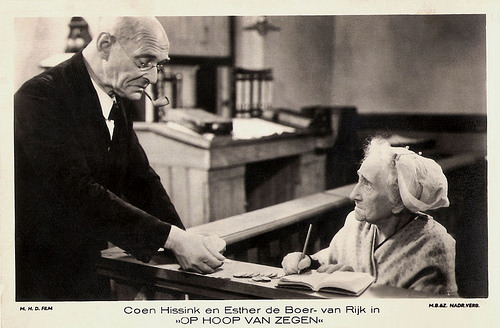
Dutch postcard by M.B. & Z / M.H.D. Film. Photo: Maarseveen, Den Haag. Publicity still for Op hoop van zegen/The Good Hope (Alex Benno, 1934) with Esther de Boer van Rijk .
Decadence, homosexuality, prostitution and cocaine
During the 1920s, Coen Hissink continued to appear in such silent films as the British-Dutch silent crime film Bloedgeld/Blood Money (Fred Goodwins, 1921), with Adelqui Migliar , the adventure film De zwarte tulp/Black Tulip (Maurits Binger, Frank Richardson, 1921) based on the novel by Alexandre Dumas père, Menschenwee (Theo Frenkel, 1921) with Louis Davids, and De Bruut/The Brute (Theo Frenkel, 1922) with Willem van der Veer, Erna Morena and Bruno Decarli .
He also appeared in such international films as the German-Dutch co-productions Der Mann im Hintergrund/The Man in the Background (Ernst Winar, 1922) with Adolphe Engers , and Frauenmoral/Women's Morals (Theo Frenkel, 1923) with Olga Engl, Helena Makowska and Theo Mann-Bouwmeester.
His final silent film was De cabaret-prinses/The Cabaret Princess (Theo Frenkel, 1925) with Emmy Arbous.
In 1928, he wrote a volume of short stories about decadence, homosexuality, prostitution and cocaine. For inspiration, he visited a gay club in Berlin where he sniffed cocaine in a toilet. The book about his experiences was titled Cocaïne: Berlijnsch zedenbeeld (Cocaine: Berlin's pictorial image).
He returned to the screen in the sound film Op Hoop van Zegen/Hoping for the best (Alex Benno, Louis Saalborn, 1934) starring Esther de Boer van Rijk and Frits van Dongen (Philip Dorn). The film was based on a 1900 play by Dutch socialist dramatist Herman Heijermans, situated in a fishing village, about the conflict between the fishermen and their employer.
It was the third filming of the play in less than twenty years. The film ends in tragedy with the unsound boat setting out to sea and sinking with all hands and the owner pocketing the insurance money. The film won an award at the Venice Film Festival in 1935 and is known as one of the most successful film productions of the Dutch pre-war cinema.
The success lead to more small roles for Hissink in the film dramas Merijntje Gijzens Jeugd/Merijntje Gijzen's Youth (Kurt Gerron, 1936) after the popular novel of the same title by A.M. de Jong, and the Dutch-French film De Man Zonder Hart/The Man Without Heart (Léo Joannon, Louis de Bree, 1937), starring Louis de Bree and Dolly Mollinger . During the 1930s he also often worked for radio plays.
Hissink’s final film role was in De Laatste Dagen van een Eiland/The Last Days of an Island (Ernst Winar, 1942) with Max Croiset . It was already shot in 1938, but premiered in 1942. The film mixes a documentary that tells about the last days of the island of Urk and its inhabitants, and a story of a young couple.
During the Second World War, Hissink refused to join the Kulturkammer (Culture Room) of the Nazi regime and he joined the Resistance. In 1941, he was caught by the Nazis and sent to the concentration camp Neuengamme in Germany. There Coen Hissink was killed in 1942. He was 64.
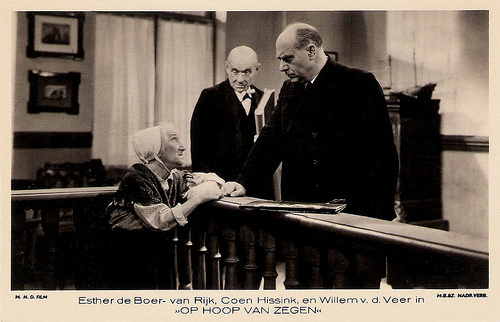
Dutch postcard by M.B. & Z. (M. Bonnist & Zonen, Amsterdam). Photo: Dick van Maarseveen, Den Haag/M.H.D. Film. Publicity still for Op Hoop van Zegen (Alex Benno, Louis Saalborn, 1934) with Esther de Boer van Rijk and Willem van der Veer. Collection Geoffrey Donaldson Institute.
Sources: Piet Hein Honig (Acteurs – en Kleinkunstenaars-Lexicon – Dutch), Eye, Wikipedia (English and Dutch) and .

Dutch postcard. Coen Hissink as Shylock in The Merchant of Venice by William Shakespeare. This postcard may date c. 1907-1908 when Hissink played Shylock on the Dutch stage.
A Dutch Western
Johan Coenraad ‘Coen’ Hissink was born in 1878 in Kampen, The Netherlands.
After studying at the Toneelschool (Stage School) for a year, he began his acting career in the theatre in 1902. He made his stage debut in the Revue De Nieuwe Haring (The New Herring) and would have a long career on stage in both the Netherlands and Flanders.
He was also known as a writer. In 1910, he published the dissertation Louis Bouwmeester's Shylock-creatie. When legendary Dutch actor Louis Bouwmeester starred as Shylock in Shakespeare's play The Merchant of Venice - his most famous - Hissink sat in the stalls with pen and paper and recorded everything he saw and heard.
Hissink was best known for his stage work, both on and behind the stage. Together with Albert van Dalsum and Eugene Gilhuys, he founded the stage company Het Groot Toneel (The Big Stage) in the Plantage theater in Amsterdam. He also played many classic stage roles, such as Othello in 1918.
Hissink made his film debut in the Dutch Western (!) Een telegram uit Mexico/A Telegram from Mexico (Louis H. Chrispijn sr., 1914), a silent short film produced by Maurits Binger for his film studio Filmfabriek Hollandia. Hissink played the blind father of the Dutch colonist Willem (Willem van der Veer), who gets lost in the revolution in Mexico. The home front waits eagerly for news.
Next followed the silent drama De Vloek van het Testament/The Fatal Woman (Maurits Binger, Louis H. Chrispijn sr., 1915) starring Dutch diva Annie Bos . At the time, it was for the Netherlands a huge production with 48 copies through Europe and 12 copies crossing to America.
Hissink continued to appear in a stream of silent Dutch films. In Fatum (Theo Frenkel, 1915) he again played with the legendary Louis Bouwmeester. Annie Bos was the star in Ontmaskerd/Unmasked (Mime Misu, 1915). Still existing is the seaman’s drama Het wrak van de Noordzee/The Wreck in the North Sea (Theo Frenkel, 1915).
Another relatively large-scale production was Het geheim van Delft/The Secret of Delft (Maurits Binger, 1916). The film required the construction of a 20 metre high ruined lighthouse, and a 15 metre long pier of the coast of Zandvoort. These constructions meant high production costs and the film starred the most famous actors in the Netherlands at that time, including Willem van der Veer, Esther De Boer-van Rijk , Jan van Dommelen and Annie Bos .
Hissink often played supporting parts as the bad guy. He had a rare leading role in the silent crime film Levensschaduwen/Life's Shadows (Theo Frenkel, 1916). He was also one of the leads in another crime film, Het Proces Begeer/The Begeer Case (Theo Frenkel, 1918). He played smaller parts in the silent dramas Pro domo (Theo Frenkel, 1918) with Louis Bouwmeester , Theo Mann-Bouwmeester and Lily Bouwmeester , and Schakels/Connections (Maurits Binger, 1920) based on a play by Herman Heijermans and starring Annie Bos , Jan van Dommelen and Adelqui Migliar .

Dutch postcard by M.B. & Z / M.H.D. Film. Photo: Maarseveen, Den Haag. Publicity still for Op hoop van zegen/The Good Hope (Alex Benno, 1934) with Esther de Boer van Rijk .
Decadence, homosexuality, prostitution and cocaine
During the 1920s, Coen Hissink continued to appear in such silent films as the British-Dutch silent crime film Bloedgeld/Blood Money (Fred Goodwins, 1921), with Adelqui Migliar , the adventure film De zwarte tulp/Black Tulip (Maurits Binger, Frank Richardson, 1921) based on the novel by Alexandre Dumas père, Menschenwee (Theo Frenkel, 1921) with Louis Davids, and De Bruut/The Brute (Theo Frenkel, 1922) with Willem van der Veer, Erna Morena and Bruno Decarli .
He also appeared in such international films as the German-Dutch co-productions Der Mann im Hintergrund/The Man in the Background (Ernst Winar, 1922) with Adolphe Engers , and Frauenmoral/Women's Morals (Theo Frenkel, 1923) with Olga Engl, Helena Makowska and Theo Mann-Bouwmeester.
His final silent film was De cabaret-prinses/The Cabaret Princess (Theo Frenkel, 1925) with Emmy Arbous.
In 1928, he wrote a volume of short stories about decadence, homosexuality, prostitution and cocaine. For inspiration, he visited a gay club in Berlin where he sniffed cocaine in a toilet. The book about his experiences was titled Cocaïne: Berlijnsch zedenbeeld (Cocaine: Berlin's pictorial image).
He returned to the screen in the sound film Op Hoop van Zegen/Hoping for the best (Alex Benno, Louis Saalborn, 1934) starring Esther de Boer van Rijk and Frits van Dongen (Philip Dorn). The film was based on a 1900 play by Dutch socialist dramatist Herman Heijermans, situated in a fishing village, about the conflict between the fishermen and their employer.
It was the third filming of the play in less than twenty years. The film ends in tragedy with the unsound boat setting out to sea and sinking with all hands and the owner pocketing the insurance money. The film won an award at the Venice Film Festival in 1935 and is known as one of the most successful film productions of the Dutch pre-war cinema.
The success lead to more small roles for Hissink in the film dramas Merijntje Gijzens Jeugd/Merijntje Gijzen's Youth (Kurt Gerron, 1936) after the popular novel of the same title by A.M. de Jong, and the Dutch-French film De Man Zonder Hart/The Man Without Heart (Léo Joannon, Louis de Bree, 1937), starring Louis de Bree and Dolly Mollinger . During the 1930s he also often worked for radio plays.
Hissink’s final film role was in De Laatste Dagen van een Eiland/The Last Days of an Island (Ernst Winar, 1942) with Max Croiset . It was already shot in 1938, but premiered in 1942. The film mixes a documentary that tells about the last days of the island of Urk and its inhabitants, and a story of a young couple.
During the Second World War, Hissink refused to join the Kulturkammer (Culture Room) of the Nazi regime and he joined the Resistance. In 1941, he was caught by the Nazis and sent to the concentration camp Neuengamme in Germany. There Coen Hissink was killed in 1942. He was 64.

Dutch postcard by M.B. & Z. (M. Bonnist & Zonen, Amsterdam). Photo: Dick van Maarseveen, Den Haag/M.H.D. Film. Publicity still for Op Hoop van Zegen (Alex Benno, Louis Saalborn, 1934) with Esther de Boer van Rijk and Willem van der Veer. Collection Geoffrey Donaldson Institute.
Sources: Piet Hein Honig (Acteurs – en Kleinkunstenaars-Lexicon – Dutch), Eye, Wikipedia (English and Dutch) and .
Published on September 23, 2017 22:00
September 22, 2017
Theo Mann-Bouwmeester
During the Netherlands Film Festival, EFSP presents the Unofficial Dutch Film Star Postcards Festival. Today's spotlight is on Dutch stage and film actress Theo Mann-Bouwmeester (1850-1939), born in a famous Dutch stage family and sister of Louis Bouwmeester. Inspired by Sarah Bernhardt, she had her breakthrough in 1880. From then on she was known for her wide repertoire, from classical tragedies to contemporary pieces. ’The Grand Dame of the Dutch stage’ also appeared in several Dutch silent films often directed by her son Theo Frenkel Sr. In 1926 she said farewell to the stage after playing her most famous role, Liane Orland in Henry Bataille's The Child of Love, in 67 cities.
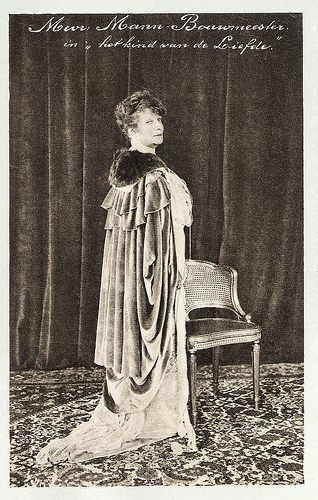
Dutch postcard by Koninkl. Nederl. Boek- en Kunsthandel M.M. Couvée, Den Haag (The Hague). Photo: publicity still for the stage production of Het kind van de liefde (L'Enfant de l'amour/The Child of Love) by Henry Bataille.
Passionate, loving and suffering women
Theodora Antonia Louisa Cornelia Bouwmeester was born in Zutphen, The Netherlands, in 1850. She was the daughter of the actors Louis Frederik Johannes Rosenveldt and Louisa Francina Maria Bouwmeester, who happened to be on tour when their daughter was born. ‘Doortje’ was born into the most important Dutch actors family and the legendary Louis Bouwmeester was her elder brother.
Doortje made her debut as a six-year-old in the stage company of her father. She continued to play small stage parts and at 17 she married musician Maurice Frenkel, with whom she would have four sons.
At 23 however, she was a widow and she decided to continue earning the money for her family as an actress. Initially, her stage career was not remarkable while she performed in melodramas and farces. In 1880, she saw a stage performance by Sarah Bernhardt in Amsterdam and ‘la divine Sarah’ became her great source of inspiration.
That same year, Theo Bouwmeester experienced her breakthrough to the main public with the title role in the French comedy Froufrou by Henri Meilhac and Ludovic Halévy and in the following years she became the grand Dame of the Dutch theatre. She was the Dutch performer in excellence of passionate, loving and suffering women – especially in great roles as Marguerite Gauthier, Maria Stuart and La Tosca.
She had a wide repertoire, from classical tragedies to contemporary pieces. From 1885 on, she was connected to the prestigious Koninklijke Vereeniging Het Nederlandsch Toneel (The Royal Dutch Theatre). In 1920, she participated in an actors strike and this would trigger the end of her career. In 1926, she said farewell in one of her popular roles, Liane Orland in Henry Bataille's Het kind van de liefde (The Child of Love).
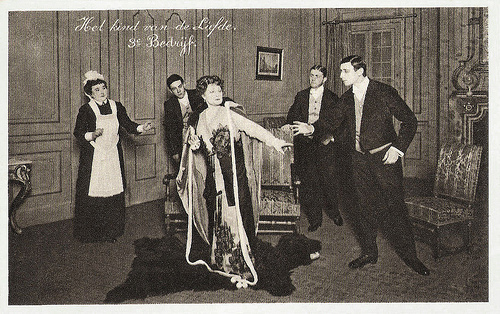
Dutch postcard by Koninkl. Nederl. Boek- en Kunsthandel M.M. Couvée, Den Haag (The Hague). Photo: publicity still for the stage production of Het kind van de liefde (The Child of Love). It was a scene from the third act.
Directed by her son
Theo Mann-Bouwmeester played in five silent films of which four were directed by her son, Theo Frenkel Sr. In her first film, Koning Oedipous/King Oedipus (1912), she played Queen Jocasta opposite her bother Louis Bouwmeester in the title role.
Six years later, her son directed her and her brother Louis Bouwmeester in Pro domo (Theo Frenkel, 1918) also with their niece Lily Bouwmeester . She had a supporting part in Helleveeg/The She-Devil (Theo Frenkel, 1920) featuring Mien Duymaer van Twist.
When her son started his own film company in Germany, she appeared in his Judith (Theo Frenkel, 1923) with Helena Makowkska . Her last film was Frauenmoral/Women's Morals (Theo Frenkel, 1923), again starring Helena Makowkska and Oscar Marion .
Theo Mann-Bouwmeester was married three times and thus performed under different names. Chronologically, she performed as Doortje Bouwmeester, Doortje Frenkel-Bouwmeester, Théo Brondgeest-Bouwmeester and Théo Bouwmeester) but she is best known under the name she used during her last marriage with the musician and composer Gottfried Mann.
Since 1950, the Theo d'Or prize has been awarded to the best female lead in the Dutch stage season every year. Another award named after her is the Theo Mann-Bouwmeester ring. This ring designed by Jan Eisenloeffe was donated to her by admirers in 1911. In 1934, Mann-Bouwmeester donated the ring to Else Mauhs, who was the most outstanding Dutch actress in her eyes. After that, the Theo Mann-Bouwmeesterring was worn by the Dutch actresses Caro van Eyck, Annet Nieuwenhuijzen, Anne Wil Blankers, Ariane Schluter and since 2017 by Halina Reijn.
Theo Mann Bouwmeester had four sons from her first marriage to Maurits Frenkel, including actor and film director Theo Frenkel sr. Actor Theo Frenkel Jr. was her grandson. There were many tragedies in her life, including the early deaths of her eldest and youngest sons. Her third son, Louis, died in 1900 at the age of 31.
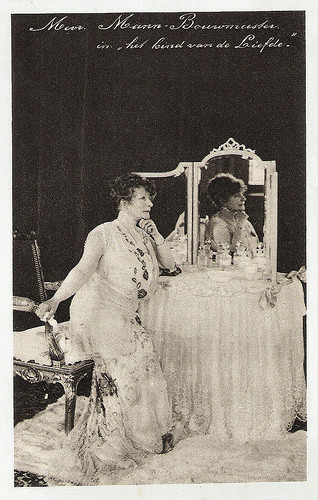
Dutch postcard by Koninkl. Nederl. Boek- en Kunsthandel M.M. Couvée, Den Haag (The Hague). Photo: publicity still for the stage production of Het kind van de liefde (The Child of Love). It was a scene from the third act.
Sources: HHJ de Leeuwe (Huygens.ing – Dutch), Piet Hein Honig (Acteurs – en Kleinkunstenaars-Lexicon – Dutch), Een levenlang theater (Dutch), Wikipedia (Dutch) and .

Dutch postcard by Koninkl. Nederl. Boek- en Kunsthandel M.M. Couvée, Den Haag (The Hague). Photo: publicity still for the stage production of Het kind van de liefde (L'Enfant de l'amour/The Child of Love) by Henry Bataille.
Passionate, loving and suffering women
Theodora Antonia Louisa Cornelia Bouwmeester was born in Zutphen, The Netherlands, in 1850. She was the daughter of the actors Louis Frederik Johannes Rosenveldt and Louisa Francina Maria Bouwmeester, who happened to be on tour when their daughter was born. ‘Doortje’ was born into the most important Dutch actors family and the legendary Louis Bouwmeester was her elder brother.
Doortje made her debut as a six-year-old in the stage company of her father. She continued to play small stage parts and at 17 she married musician Maurice Frenkel, with whom she would have four sons.
At 23 however, she was a widow and she decided to continue earning the money for her family as an actress. Initially, her stage career was not remarkable while she performed in melodramas and farces. In 1880, she saw a stage performance by Sarah Bernhardt in Amsterdam and ‘la divine Sarah’ became her great source of inspiration.
That same year, Theo Bouwmeester experienced her breakthrough to the main public with the title role in the French comedy Froufrou by Henri Meilhac and Ludovic Halévy and in the following years she became the grand Dame of the Dutch theatre. She was the Dutch performer in excellence of passionate, loving and suffering women – especially in great roles as Marguerite Gauthier, Maria Stuart and La Tosca.
She had a wide repertoire, from classical tragedies to contemporary pieces. From 1885 on, she was connected to the prestigious Koninklijke Vereeniging Het Nederlandsch Toneel (The Royal Dutch Theatre). In 1920, she participated in an actors strike and this would trigger the end of her career. In 1926, she said farewell in one of her popular roles, Liane Orland in Henry Bataille's Het kind van de liefde (The Child of Love).

Dutch postcard by Koninkl. Nederl. Boek- en Kunsthandel M.M. Couvée, Den Haag (The Hague). Photo: publicity still for the stage production of Het kind van de liefde (The Child of Love). It was a scene from the third act.
Directed by her son
Theo Mann-Bouwmeester played in five silent films of which four were directed by her son, Theo Frenkel Sr. In her first film, Koning Oedipous/King Oedipus (1912), she played Queen Jocasta opposite her bother Louis Bouwmeester in the title role.
Six years later, her son directed her and her brother Louis Bouwmeester in Pro domo (Theo Frenkel, 1918) also with their niece Lily Bouwmeester . She had a supporting part in Helleveeg/The She-Devil (Theo Frenkel, 1920) featuring Mien Duymaer van Twist.
When her son started his own film company in Germany, she appeared in his Judith (Theo Frenkel, 1923) with Helena Makowkska . Her last film was Frauenmoral/Women's Morals (Theo Frenkel, 1923), again starring Helena Makowkska and Oscar Marion .
Theo Mann-Bouwmeester was married three times and thus performed under different names. Chronologically, she performed as Doortje Bouwmeester, Doortje Frenkel-Bouwmeester, Théo Brondgeest-Bouwmeester and Théo Bouwmeester) but she is best known under the name she used during her last marriage with the musician and composer Gottfried Mann.
Since 1950, the Theo d'Or prize has been awarded to the best female lead in the Dutch stage season every year. Another award named after her is the Theo Mann-Bouwmeester ring. This ring designed by Jan Eisenloeffe was donated to her by admirers in 1911. In 1934, Mann-Bouwmeester donated the ring to Else Mauhs, who was the most outstanding Dutch actress in her eyes. After that, the Theo Mann-Bouwmeesterring was worn by the Dutch actresses Caro van Eyck, Annet Nieuwenhuijzen, Anne Wil Blankers, Ariane Schluter and since 2017 by Halina Reijn.
Theo Mann Bouwmeester had four sons from her first marriage to Maurits Frenkel, including actor and film director Theo Frenkel sr. Actor Theo Frenkel Jr. was her grandson. There were many tragedies in her life, including the early deaths of her eldest and youngest sons. Her third son, Louis, died in 1900 at the age of 31.

Dutch postcard by Koninkl. Nederl. Boek- en Kunsthandel M.M. Couvée, Den Haag (The Hague). Photo: publicity still for the stage production of Het kind van de liefde (The Child of Love). It was a scene from the third act.
Sources: HHJ de Leeuwe (Huygens.ing – Dutch), Piet Hein Honig (Acteurs – en Kleinkunstenaars-Lexicon – Dutch), Een levenlang theater (Dutch), Wikipedia (Dutch) and .
Published on September 22, 2017 22:00
September 21, 2017
Henkie Klein
Every year in early autumn, the Dutch film industry and public gather at the Netherlands Film Festival (NFF). Also this year, EFSP presents its own Unofficial Netherlands Film Star Postcards Festival from 20 to 29 September. Today in the spotlight: little Henkie Klein (1921-ca. 1993), who was a child actor in German and Dutch films of the silent era. He was called the 'Dutch Jackie Coogan'.
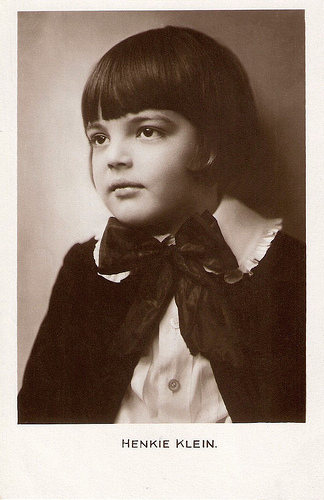
Dutch postcard by B. Brouwer, Amsterdam. Photo: Bernard Eilers, Amsterdam. Collection: Geoffrey Donaldson Institute.
Dream World
Henkie Klein (sometimes written as Klyn or Kleinman) was born in Amsterdam, The Netherlands in 1921. He was the son of film director Henk Kleinman(n). Some sources say Kleinman senior was Dutch, other sources say he was German born.
Kleinman sr. was the producer and co-director of the German-Dutch film Die Fahrt ins Verderben/Op hoop van zegen (Henk Kleinman, James Bauer, 1924). This was the second film version of Op hoop van zegen/On hope of blessing, a classic Dutch fisher drama written by Herman Heijermans in 1900.
The success of the production lead to another film based on a play by Heijermans, Die vom Schicksal Verfolgten/Droomkoninkje/Little Dream King (Henk Kleinman, 1926) with Wilhelm Dieterle (aka William Dieterle) and Aud Egede Nissen . Little Henkie played the lead of a boy born with a clubfoot who creates his own dream world.
A year earlier Henkie had made his film debut as the Berlin street boy Bolleken in Goldjunge/Stille Nacht, Heilige Nacht/Golden Boy (Henk Kleinman, 1925) with Grete Reinwald and Carl Auen . Both films are now presumed missing.
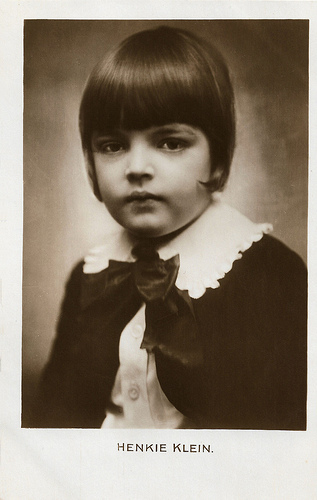
Dutch postcard printed by B. Brouwer, Amsterdam. Photo: Bernard F. Eilers.
Glimpse
At the age of 9, Henkie Klein played in the melodrama Zeemansvrouwen/Seamen's Wives (Henk Kleinman, 1930), based on a play by Herman Bouber, author of popular plays like De Jantjes/The Tars and Bleeke Bet/Pale Beth. Zeemansvrouwen should have been the first Dutch sound film with some songs. Possibly because of a lack of money, it became the last Dutch silent feature film.
The prints have been restored by the former Dutch Filmmuseum (now Eye Institute) and reviewer rohitnnn writes at IMDb : "Some of the shots in the film are truly exquisite, and though the story is almost entirely predictable, the film is eminently watchable as it shows us a glimpse of the society in a country that otherwise remains at the periphery of European cinema."
Zeemansvrouwen/Seamen's Wives was one of the most popular films of that year in the Amsterdam cinemas, but Henkie would only act in one more film by his father, Hollands jeugd/Dutch Youth (Henk Kleinman, 1934). There is little know about this production. Kleinman senior also directed two other films, Zelfkant/Fag-end (Henk Kleinman, 1931), a short promotion film for the association for Help for Uninhabited, and the short Oudjes/Oldies (Henk Kleinman, 1936) with Louis van Dommelen, Riek Kloppenburg and August Kiehl.
In 1934, Dutch film weekly Het Weekblad Cinema en Theater published a small article about Henkie: "In the last few years, we did not hear much of the young Dutch film star Henkie Klein. After his outstanding role in the Dutch film Droomkoninkje, he completely disappeared. This is probably because his father, director Henk Kleinman, does not get any more films to direct. Henkie visits the primary school in Amsterdam. He has almost become a Henk now."
In Dutch newspaper NRC Handelsblad , Henk van Gelder wrote in 2003 about what happened to Henk Kleinman senior. Documents from film historian Egbert Barten show that Kleinman joined the NSB in 1934 and the Reichsfilmkammer in 1937 to be able to work in Germany. During the war he worked - again as Henk Kleinmann - in Germany for a small bureau that selected suitable German films for The Netherlands. He died in 1944 (other sources say 1945) without making another film in Germany. His train was bombed by allied forces and he died in a hospital in Berlin.
An what happened to his son Henkie? Van Gelder cites theatre historian Piet Hein Honig who said that Henk Klein passed away circa 1993. Van Gelder contacted Henkie's daughter, but she just gave him information about her grandfather.
In 2003, Zeemansvrouwen/Seamen's Wives was studied by lip readers and new film texts by Lodewijk de Boer were dubbed by actors like Huib Broos, Jeroen Krabbé , Nelly Frijda en Bram van der Vlugt. Henny Vrienten composed a new musical score for this film experiment. That same year, this final sound version was screened during the Biënnale in the Filmmuseum in Amsterdam.
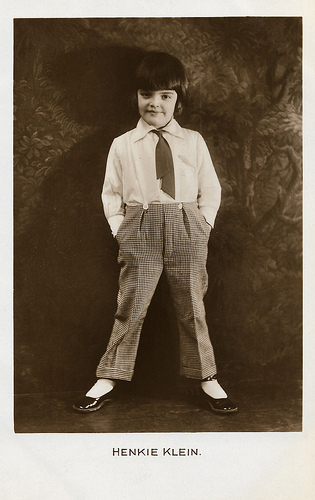
Dutch postcard printed by B. Brouwer, Amsterdam. Photo: Bernard F. Eilers.
Sources: Henk van Gelder (NRC Handelsblad - Dutch), Peter Bosma (Dutch), Mariska Graveland (De Filmkrant - Dutch), Rohitnnn (IMDb), Dutch Film Angle, Wikipedia and .

Dutch postcard by B. Brouwer, Amsterdam. Photo: Bernard Eilers, Amsterdam. Collection: Geoffrey Donaldson Institute.
Dream World
Henkie Klein (sometimes written as Klyn or Kleinman) was born in Amsterdam, The Netherlands in 1921. He was the son of film director Henk Kleinman(n). Some sources say Kleinman senior was Dutch, other sources say he was German born.
Kleinman sr. was the producer and co-director of the German-Dutch film Die Fahrt ins Verderben/Op hoop van zegen (Henk Kleinman, James Bauer, 1924). This was the second film version of Op hoop van zegen/On hope of blessing, a classic Dutch fisher drama written by Herman Heijermans in 1900.
The success of the production lead to another film based on a play by Heijermans, Die vom Schicksal Verfolgten/Droomkoninkje/Little Dream King (Henk Kleinman, 1926) with Wilhelm Dieterle (aka William Dieterle) and Aud Egede Nissen . Little Henkie played the lead of a boy born with a clubfoot who creates his own dream world.
A year earlier Henkie had made his film debut as the Berlin street boy Bolleken in Goldjunge/Stille Nacht, Heilige Nacht/Golden Boy (Henk Kleinman, 1925) with Grete Reinwald and Carl Auen . Both films are now presumed missing.

Dutch postcard printed by B. Brouwer, Amsterdam. Photo: Bernard F. Eilers.
Glimpse
At the age of 9, Henkie Klein played in the melodrama Zeemansvrouwen/Seamen's Wives (Henk Kleinman, 1930), based on a play by Herman Bouber, author of popular plays like De Jantjes/The Tars and Bleeke Bet/Pale Beth. Zeemansvrouwen should have been the first Dutch sound film with some songs. Possibly because of a lack of money, it became the last Dutch silent feature film.
The prints have been restored by the former Dutch Filmmuseum (now Eye Institute) and reviewer rohitnnn writes at IMDb : "Some of the shots in the film are truly exquisite, and though the story is almost entirely predictable, the film is eminently watchable as it shows us a glimpse of the society in a country that otherwise remains at the periphery of European cinema."
Zeemansvrouwen/Seamen's Wives was one of the most popular films of that year in the Amsterdam cinemas, but Henkie would only act in one more film by his father, Hollands jeugd/Dutch Youth (Henk Kleinman, 1934). There is little know about this production. Kleinman senior also directed two other films, Zelfkant/Fag-end (Henk Kleinman, 1931), a short promotion film for the association for Help for Uninhabited, and the short Oudjes/Oldies (Henk Kleinman, 1936) with Louis van Dommelen, Riek Kloppenburg and August Kiehl.
In 1934, Dutch film weekly Het Weekblad Cinema en Theater published a small article about Henkie: "In the last few years, we did not hear much of the young Dutch film star Henkie Klein. After his outstanding role in the Dutch film Droomkoninkje, he completely disappeared. This is probably because his father, director Henk Kleinman, does not get any more films to direct. Henkie visits the primary school in Amsterdam. He has almost become a Henk now."
In Dutch newspaper NRC Handelsblad , Henk van Gelder wrote in 2003 about what happened to Henk Kleinman senior. Documents from film historian Egbert Barten show that Kleinman joined the NSB in 1934 and the Reichsfilmkammer in 1937 to be able to work in Germany. During the war he worked - again as Henk Kleinmann - in Germany for a small bureau that selected suitable German films for The Netherlands. He died in 1944 (other sources say 1945) without making another film in Germany. His train was bombed by allied forces and he died in a hospital in Berlin.
An what happened to his son Henkie? Van Gelder cites theatre historian Piet Hein Honig who said that Henk Klein passed away circa 1993. Van Gelder contacted Henkie's daughter, but she just gave him information about her grandfather.
In 2003, Zeemansvrouwen/Seamen's Wives was studied by lip readers and new film texts by Lodewijk de Boer were dubbed by actors like Huib Broos, Jeroen Krabbé , Nelly Frijda en Bram van der Vlugt. Henny Vrienten composed a new musical score for this film experiment. That same year, this final sound version was screened during the Biënnale in the Filmmuseum in Amsterdam.

Dutch postcard printed by B. Brouwer, Amsterdam. Photo: Bernard F. Eilers.
Sources: Henk van Gelder (NRC Handelsblad - Dutch), Peter Bosma (Dutch), Mariska Graveland (De Filmkrant - Dutch), Rohitnnn (IMDb), Dutch Film Angle, Wikipedia and .
Published on September 21, 2017 22:00
September 20, 2017
Fanfare (1958)
During the Netherlands Film Festival, EFSP presents the Unofficial Dutch Film Star Postcards Festival. One of the classics of the Dutch cinema is the comedy Fanfare (Bert Haanstra, 1958). The film was entered into the 1959 Cannes Film Festival. With 2,6 million visitors it is the second biggest box office hit in the history of the Dutch cinema.
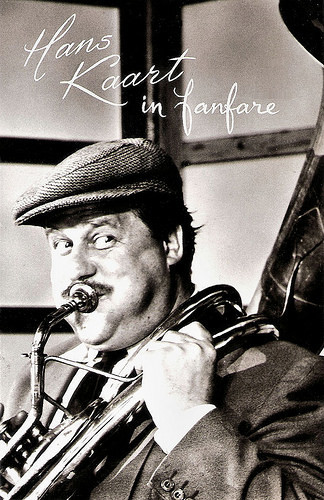
Dutch postcard by Uitg. Takken, Utrecht, no. 3796. Photo: Jutka Mol-Rona / Sapphire Film Productie. Publicity still for Fanfare (Bert Haanstra, 1958) with Hans Kaart.
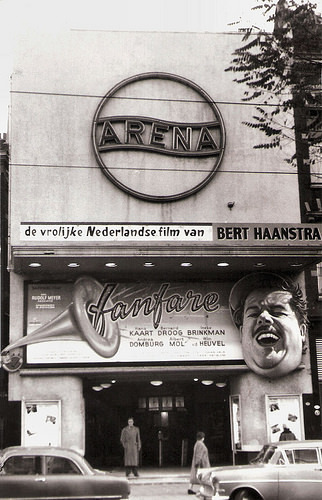
Dutch postcard by A. de Herder, Rotterdam. The Arena Cinema was located at the Kruiskade, Rotterdam, The Netherlands. The presented film was the Dutch comedy Fanfare (Bert Haanstra, 1958), starring Hans Kaart.
Classic Dutch Comedy
Fanfare (1958) is a classic Dutch comedy film of the 1950s directed by Bert Haanstra. The film was entered into the 1959 Cannes Film Festival and the 1st Moscow International Film Festival.
Fanfare belongs to the milestones of Dutch film history. With over 2,6 million cinema visitors it is the second most successful Dutch film of all time, only surpassed by Paul Verhoeven's Turks Fruit/Turkish Delight (1973) with Rutger Hauer and Monique van de Ven.
Fanfare was filmed in the village of Giethoorn, in the film the fictional place of Brederwiede, a typical 1950s village, with canals instead of roads.
The scenario was written by director Bert Haanstra and journalist/author Jan Blokker. The music was composed by Jan Mul and was performed by the Concertgebouworkest.
The story: after a fight between the two leading musicians (Hans Kaart and Bernard Droog) the brass band in a small village splits up into two separate bands. They both want to win a contest and will do anything to prevent the other band from winning it.
There is also a love story: the young policeman (Wim van den Heuvel) and the girl (Ineke Brinkman) are both children of one of the band leaders.
At the end of the film, the two rival brass bands end up on a music tournament. The two pieces of music of the rival brass bands are combined by a planned coincidence. Haanstra filmed this competition on a meadow in Diever. He used musicians of various corps from the Diever region as a figurant.
The film was Bert Haanstra's feature film debut and is unique in the Dutch cinema. The cost was 450 thousand guilders, but the film raised 1.2 million guilders.

Dutch postcard van Leer's Fotodrukind. N.V., no. 659, sent in 1960. This the brassband which performed in Fanfare (Bert Haanstra, 1958).
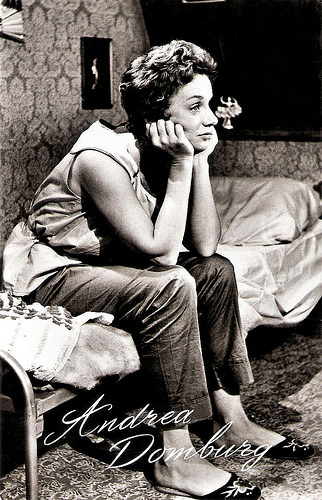
Dutch postcard by Uitg. Takken, Utrecht, no. 3792. Photo: Jutka Mol-Rona / Sapphire Film Productie. Publicity still for Fanfare (Bert Haanstra, 1958) with Andrea Domburg .
Ineke Brinkman
Dutch actress and film actress Ineke Brinkman (1934) was active in the Netherlands and Norway. She studied acting with actor Bernard Droog and at the London Academy of Music and Dramatic Art.
In 1954, she made her stage debut in Summer and Smoke by Tennessee Williams. In 1958 she played a role in the popular film Fanfare (Bert Haanstra, 1958) with Hans Kaart, Bernard Droog, Andrea Domburg and Wim van den Heuvel.
After a fight the brass band (in Dutch: fanfare) in the small village of Giethoorn splits up into two separate bands. They both want to win a contest and will do anything to prevent the other band from winning it.
In 1960 Brinkman received a prize for her role in the play Five Finger Exercise by Peter Shaffer. Brinkman married a Norwegian in 1958 and soon she moved to Norway. There she went to direct amateur plays and acted at the National Theater and Det norske teatret in Oslo.
In 1977 she founded a cabaret which still exists. She returned in 1984 to the Netherlands for a short time and appeared on TV in the comedy series Schoppentroef/Spades trump (Bram van Erkel a.o., 1984) with Gerard Cox and she also acted in a stage production.
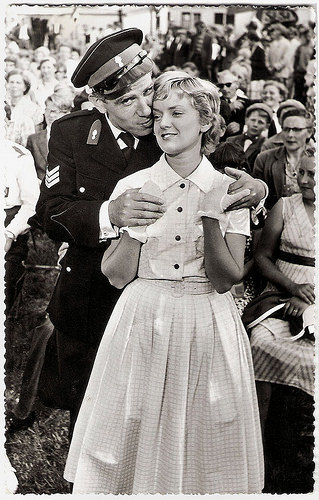
Dutch postcard by Int. Filmpers (IFP), Amsterdam, no. 1920. Photo: publicity still for Fanfare (Bert Haanstra, 1958) with Ineke Brinkman and Wim van den Heuvel.
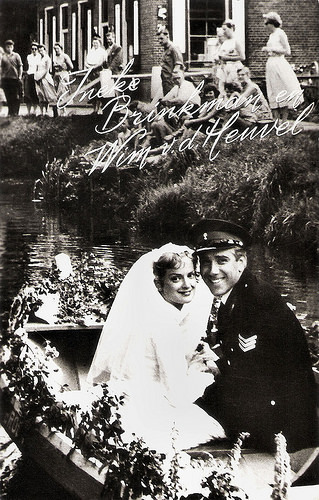
Dutch postcard by Uitg. Takken, Utrecht, no. 3794. Photo: Jutka Mol-Rona / Sapphire Film Productie. Publicity still for Fanfare (Bert Haanstra, 1958)Dutch postcard by Int. Filmpers (IFP), Amsterdam, no. 1920. Photo: publicity still for Fanfare (Bert Haanstra, 1958) with Ineke Brinkman and Wim van den Heuvel.
Wim van den Heuvel
Dutch actor Wim van den Heuvel (1928) was the Jeune Premier of the classic Dutch feature film Fanfare (Bert Haanstra, 1958). He played police officer Douwe, who is in love with Marije (Ineke Brinkman).
Fanfare made him well known in the Netherlands and he appeared in many TV plays and series. On stage he performed at the theatre companies Puck, Ensemble, De Nederlandse Comedie, Toneelgroep Centrum, De Haagse Comedie and Het Nationale Toneel.
Films in which he appeared are Kermis in de regen/Fair in the Rain (Kees Brusse, 1962), Ongewijde aarde/Unconsecrated Earth (Jef van der Heijden, 1967) with Ton Lensink, and Minoes/Miss Minoes (Vincent Bal, 2001) starring Carice van Houten.
Wim van den Heuvel was married to actress Karin Haage and since 1972 to actress Guusje Westermann. The actor André van den Heuvel is his brother.
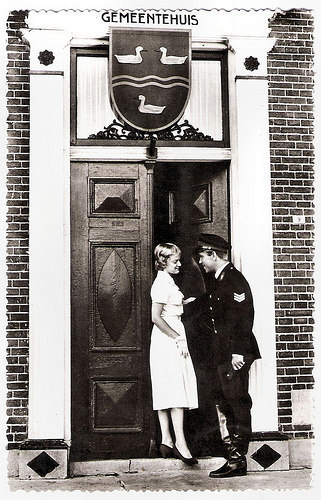
Dutch postcard by Int. Filmpers (IFP), Amsterdam, no. 1932. Photo: publicity still for Fanfare (Bert Haanstra, 1958) with Ineke Brinkman and Wim van den Heuvel.
Trailer Fanfare (1958). Source: indebioscoop (YouTube).
Impressions of the shooting of Fanfare. Source: PunterRadio1 (YouTube).
Sources: Wikipedia (Dutch) and IMDb

Dutch postcard by Uitg. Takken, Utrecht, no. 3796. Photo: Jutka Mol-Rona / Sapphire Film Productie. Publicity still for Fanfare (Bert Haanstra, 1958) with Hans Kaart.

Dutch postcard by A. de Herder, Rotterdam. The Arena Cinema was located at the Kruiskade, Rotterdam, The Netherlands. The presented film was the Dutch comedy Fanfare (Bert Haanstra, 1958), starring Hans Kaart.
Classic Dutch Comedy
Fanfare (1958) is a classic Dutch comedy film of the 1950s directed by Bert Haanstra. The film was entered into the 1959 Cannes Film Festival and the 1st Moscow International Film Festival.
Fanfare belongs to the milestones of Dutch film history. With over 2,6 million cinema visitors it is the second most successful Dutch film of all time, only surpassed by Paul Verhoeven's Turks Fruit/Turkish Delight (1973) with Rutger Hauer and Monique van de Ven.
Fanfare was filmed in the village of Giethoorn, in the film the fictional place of Brederwiede, a typical 1950s village, with canals instead of roads.
The scenario was written by director Bert Haanstra and journalist/author Jan Blokker. The music was composed by Jan Mul and was performed by the Concertgebouworkest.
The story: after a fight between the two leading musicians (Hans Kaart and Bernard Droog) the brass band in a small village splits up into two separate bands. They both want to win a contest and will do anything to prevent the other band from winning it.
There is also a love story: the young policeman (Wim van den Heuvel) and the girl (Ineke Brinkman) are both children of one of the band leaders.
At the end of the film, the two rival brass bands end up on a music tournament. The two pieces of music of the rival brass bands are combined by a planned coincidence. Haanstra filmed this competition on a meadow in Diever. He used musicians of various corps from the Diever region as a figurant.
The film was Bert Haanstra's feature film debut and is unique in the Dutch cinema. The cost was 450 thousand guilders, but the film raised 1.2 million guilders.

Dutch postcard van Leer's Fotodrukind. N.V., no. 659, sent in 1960. This the brassband which performed in Fanfare (Bert Haanstra, 1958).

Dutch postcard by Uitg. Takken, Utrecht, no. 3792. Photo: Jutka Mol-Rona / Sapphire Film Productie. Publicity still for Fanfare (Bert Haanstra, 1958) with Andrea Domburg .
Ineke Brinkman
Dutch actress and film actress Ineke Brinkman (1934) was active in the Netherlands and Norway. She studied acting with actor Bernard Droog and at the London Academy of Music and Dramatic Art.
In 1954, she made her stage debut in Summer and Smoke by Tennessee Williams. In 1958 she played a role in the popular film Fanfare (Bert Haanstra, 1958) with Hans Kaart, Bernard Droog, Andrea Domburg and Wim van den Heuvel.
After a fight the brass band (in Dutch: fanfare) in the small village of Giethoorn splits up into two separate bands. They both want to win a contest and will do anything to prevent the other band from winning it.
In 1960 Brinkman received a prize for her role in the play Five Finger Exercise by Peter Shaffer. Brinkman married a Norwegian in 1958 and soon she moved to Norway. There she went to direct amateur plays and acted at the National Theater and Det norske teatret in Oslo.
In 1977 she founded a cabaret which still exists. She returned in 1984 to the Netherlands for a short time and appeared on TV in the comedy series Schoppentroef/Spades trump (Bram van Erkel a.o., 1984) with Gerard Cox and she also acted in a stage production.

Dutch postcard by Int. Filmpers (IFP), Amsterdam, no. 1920. Photo: publicity still for Fanfare (Bert Haanstra, 1958) with Ineke Brinkman and Wim van den Heuvel.

Dutch postcard by Uitg. Takken, Utrecht, no. 3794. Photo: Jutka Mol-Rona / Sapphire Film Productie. Publicity still for Fanfare (Bert Haanstra, 1958)Dutch postcard by Int. Filmpers (IFP), Amsterdam, no. 1920. Photo: publicity still for Fanfare (Bert Haanstra, 1958) with Ineke Brinkman and Wim van den Heuvel.
Wim van den Heuvel
Dutch actor Wim van den Heuvel (1928) was the Jeune Premier of the classic Dutch feature film Fanfare (Bert Haanstra, 1958). He played police officer Douwe, who is in love with Marije (Ineke Brinkman).
Fanfare made him well known in the Netherlands and he appeared in many TV plays and series. On stage he performed at the theatre companies Puck, Ensemble, De Nederlandse Comedie, Toneelgroep Centrum, De Haagse Comedie and Het Nationale Toneel.
Films in which he appeared are Kermis in de regen/Fair in the Rain (Kees Brusse, 1962), Ongewijde aarde/Unconsecrated Earth (Jef van der Heijden, 1967) with Ton Lensink, and Minoes/Miss Minoes (Vincent Bal, 2001) starring Carice van Houten.
Wim van den Heuvel was married to actress Karin Haage and since 1972 to actress Guusje Westermann. The actor André van den Heuvel is his brother.

Dutch postcard by Int. Filmpers (IFP), Amsterdam, no. 1932. Photo: publicity still for Fanfare (Bert Haanstra, 1958) with Ineke Brinkman and Wim van den Heuvel.
Trailer Fanfare (1958). Source: indebioscoop (YouTube).
Impressions of the shooting of Fanfare. Source: PunterRadio1 (YouTube).
Sources: Wikipedia (Dutch) and IMDb
Published on September 20, 2017 22:00
September 19, 2017
Louis Davids
Every year in early autumn, the Dutch film industry and public gather at the Netherlands Film Festival (NFF). For ten days, Utrecht is the capital of the Dutch cinema. During the festival, EFSP provides you daily with postcards of Dutch films and stars from the past. Today we start with Dutch cabaret and revue artist Louis Davids (1883-1939), who appeared in twenty Dutch films, both silent and sound pictures. He is widely considered one of the Netherlands biggest names in performing arts ever and many of his songs are evergreens in The Netherlands.
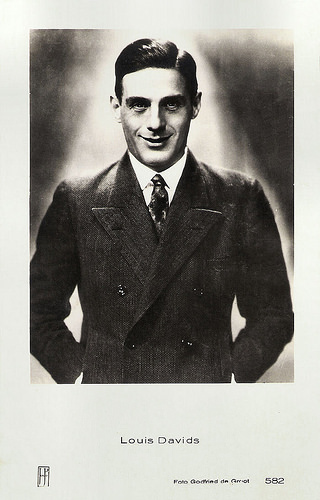
Dutch postcard by JosPe, no. 582. Photo: Godfried de Groot.
Wonder Child
Louis Davids was born as Simon David in 1883 in Rotterdam's notorious Zandstraat quarter into a poor Jewish family. He was the son of the comedian and cafe owner Levie David and Francina Terveen. Both parents were performing artists and their children Louis, his older brother Hakkie and younger sisters Rika and Heintje started their entertainment career at a young age.
5 years old, Louis sang in mini-costume and high hat at all the state fairs with his brother Hakkie playing the piano. Newspapers called little Louis a ‘Wonder child’ or ‘Miniature Comedian’ and he was very successful. A big chance came a few years later. Only seven, he got a contract at Tivoli Theater in Rotterdam, where he performed under the name Louis Davids Jr.
Later he performed with his sister Rika on fairs and in coffee houses and music halls and he became a versatile artist. After an argument with his father, the 13-years-old left for England to be an assistant to the magician Akimoto. A year later, his father brought his son home, penniless but with a lot more experience in variety theatre. Together with his sister Rika he managed to secure a job outside of the fairs, working at the famous theatre Pschorr.
Brother and sister Davids moved to Amsterdam to work with by the variety director Frits van Haarlem at the Carré circus theatre where they had plenty of success in creating revues after English fashion. In the cafe-chantant Victoria in the Nes (a street in the old centre of Amsterdam) they performed songs like Een reisje langs den Rijn (A trip along the Rhine). During that time, the Nes and the artists who performed there were not really highly rated. Louis therefore hopes to return to Frits van Haarlem.
After Rika married English magician John Weil and moved to England, Louis formed a new duo with his youngest sister Henriëtte (Heintje). The second Davids duo was also a success. Heintje’s husband, Philip Pinkhof, wrote texts for the duo. In 1906, Davids married Rebecca Kokernoot with whom he had a daughter, Kitty. He was unhappy in his marriage.
Louis’ breakthrough was Koning 'Kziezoowat in Amsterdam/King Sissiwat in Amsterdam (1906). This was the first major revue in the Netherlands, written by Louis Davids and Frits van Haarlem, and with Davids in the leading role. For this revue four short films with Louis and Heintje Davids were produced by Frits van Haarlem, which became parts of the revue.
In 1909 Davids furthered his success by working with theatre director Henri ter Hall in the revue Doe er een deksel op (Make it a cover). The performances took place in Rotterdam, his birthplace. Rika was back and Heintje had a characteristic role. As with the previous revue, it was especially up to local events and the surprise element was the key to its success.
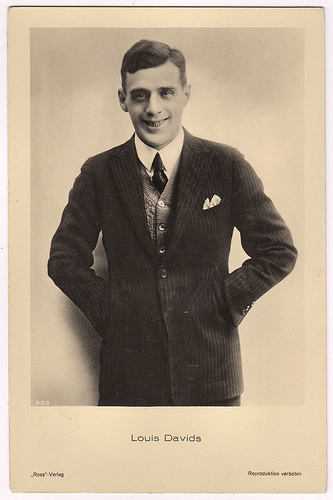
German postcard by Ross Verlag, no. 803, 1925-1926. Collection: Marlene Pilaete.
He, She and the Piano
While on tour Louis Davids met British dancer Margie Morris who had moved to the Netherlands in 1913. Louis and Maggie formed the duo ‘He, She and the Piano’, where Maggie would take on the role as pianist and composer. They wrote dozens of songs together, he the text, she the music.
The charming Morris led him from the comic repertoire towards more mature songs. Margie encouraged Louis' artistic talents and helped him develop his own style. Thanks to the influence of English and American music in her compositions, the level of Louis’s songs increased. Their innovating, a bit jazz-like repertoire soon became known across the country. Davids and Morris also starred in countless revue such as Loop naar den Duivel (Walk to the Devil) in 1915, for which they wrote We gaan naar Zandvoort aan de zee (We go to Zandvoort by the sea), now a Dutch evergreen.
They also started to appear in the Dutch cinema. Their silent films include Amerikaansche meisjes/American Girls (Maurits Binger, Louis Davids, 1918) with Lola Cornero and Beppie de Vries, and De duivel in Amsterdam/The Devil in Amsterdam (Theo Frenkel, 1919) with Eduard Verkade and Louis Bouwmeester .
A famous stage musical from this period, for which they wrote several classic songs, is De Jantjes (The Tars) written by Herman Bouber and Davids in 1920. This hugely successful stage play was also released as a silent film, De Jantjes/The Tars (Maurits Binger, B.E. Doxat-Pratt, 1922) starring Beppie de Vries and Johan Elsensohn , and as a sound film, De Jantjes/The Tars (Jaap Speyer, 1934).
Bouber, Davids and Morris also wrote the stage musicals Bleeke Bet/Bleak Beth (1917) and Oranje Hein/Orange Hein (1918), all situated in the Jordaan. Davids also appeared in other silent films such as the Herman Heijermans adaptation Schakels/Links (Maurits Binger, 1920) with Jan van Dommelen , Adelqui Migliar and Annie Bos , and Menschenwee/People woe (Theo Frenkel, 1921) with Willem van der Veer and Coen Hissink.
Davids celebrated his 25th anniversary as an artist in 1919 in Rotterdam's Pschorr theatre. After his jubilee Louis travelled with Margie, Rika and Heintje to India for a year and a half. In 1922 Margie Morris left him because of his countless infidelities. The couple had never married but they had a son together, Louis. His wife Betsy refused to divorce Louis, so they remained officially married until his death. Both Louis’s children would never have a good relationship with their father in their mature lives.
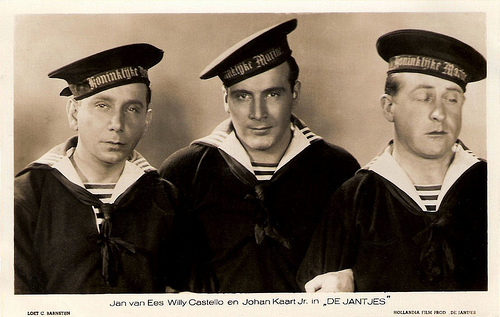
Dutch postcard by Hollandia Film Prod. / Loet C. Barnstijn. Photo: publicity still for De Jantjes/The Tars (Jaap Speyer, 1934) with Jan van Ees , Willy Costello and Johan Kaart jr. as the three 'Jantjes'.
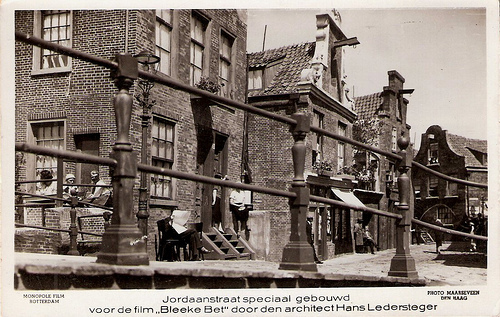
Dutch postcard by Monopole Film, Rotterdam. Photo: Dick van Maarseveen. Still of a set built for Bleeke Bet (Alex Benno, Richard Oswald, 1934), a street in the old neighbourhood De Jordaan in Amsterdam. Set designer was Hans Ledersteger.
The Little Man
Between 1922 and 1926, Louis Davids was the director of the Casino Variété in Rotterdam, but the job of director did not hold his attention for long. In 1929, Davids appeared in the revue Lach en vergeet (Laugh and Forget) with the song which would probably become his most popular title De kleine man (The Little Man). It was written by Jacques van Tol, with whom Davids would work closely until his death in 1939, but Van Tol would be working anonymously.
Despite he was born in Rotterdam, Louis Davids was a popular performer of the ‘Jordaan repertoire’. The Jordaan is a 17th century-built working class neighbourhood in the heart of Amsterdam. Davids also appeared in typical ‘Jordaan films’, a genre based on the popular plays by Herman Bouber and Davids and Morris, such as Bleeke Bet/Bleak Beth (Alex Benno, 1923) with Alida van Gijtenbeek and Jan van Dommelen , and Oranje Hein/Orange Hein (Alex Benno, 1925), starring Johan Elsensohn and Aaf Bouber .
Davids made the transition to sound film in the short Hollandsch Hollywood/Dutch Hollywood (Ernst Winar, 1933), also with Heintje Davids and Fien de la Mar . After the enormous success of the sound version of De Jantjes/The Tars (Jaap Speyer, 1934), he made one more film, Op stap/On the Move (Ernst Winar, 1935), co-starring Fien de la Mar and Frits van Dongen (a.k.a. Philip Dorn). In this musical Davids sang several songs, including his evergreen Als je voor een dubbeltje geboren bent (When you are born for a nickel).
At the time, Davids was especially renowned for his work for the Scheveningen Kurhaus Cabaret in the summers from 1931 till 1938. There Davids founded the careers of Dutch cabaret stars like Wim Kan, Corry Vonk , and Wim Sonneveld . In 1937 Davids had to give up his cabaret work at the Kurhaus due to his asthma. That year, he was named Knight in the Order of Orange-Nassau.
In 1939, Louis Davids died in Amsterdam, only 55. (Some sources, like IMDb , mention cancer as the cause, other sources mention a heart attack or his asthma as the cause). During the Second World War, Rika and Harkie Davids both were murdered in 1943 in Sobibor concentration camp. Heintje knew to survive the Nazis. After the war she continued to perform and keep the repertoire of her brother alive. Today, Louis Davids’s songs are still popular. They can be heard on the soundtrack of films like Rooie Sien/Red Sien (Frans Weisz, 1975) featuring Willeke Alberti , and TV series like Moeder, ik wil bij de revue/Mother, I want to join the revue (Rita Horst, 2012) with Egbert Jan Weeber.
Heintje Davids and Sylvain Poons sing Omdat ik zoveel van je hou (Beacause I love you so much) in De Jantjes/The Tars (Jaap Speyer, 1934). Source: Pieter de Groot (YouTube).
Louis Davids sings Als je voor een dubbeltje geboren bent (When you are born for a nickel) in Op stap/On the Move (Ernst Winar, 1935). Source: brassens66 (YouTube).
Sources: Heintje Davids, Johan Luger, H.P. van den Aardweg (Louis Davids, Een kleine man die je nooit vergeet – Dutch), M.E.H.N. Mout (Huygens.nl - Dutch), Een leven lang theater (Dutch), Stadsarchief Rotterdam (Dutch), Wikipedia and .

Dutch postcard by JosPe, no. 582. Photo: Godfried de Groot.
Wonder Child
Louis Davids was born as Simon David in 1883 in Rotterdam's notorious Zandstraat quarter into a poor Jewish family. He was the son of the comedian and cafe owner Levie David and Francina Terveen. Both parents were performing artists and their children Louis, his older brother Hakkie and younger sisters Rika and Heintje started their entertainment career at a young age.
5 years old, Louis sang in mini-costume and high hat at all the state fairs with his brother Hakkie playing the piano. Newspapers called little Louis a ‘Wonder child’ or ‘Miniature Comedian’ and he was very successful. A big chance came a few years later. Only seven, he got a contract at Tivoli Theater in Rotterdam, where he performed under the name Louis Davids Jr.
Later he performed with his sister Rika on fairs and in coffee houses and music halls and he became a versatile artist. After an argument with his father, the 13-years-old left for England to be an assistant to the magician Akimoto. A year later, his father brought his son home, penniless but with a lot more experience in variety theatre. Together with his sister Rika he managed to secure a job outside of the fairs, working at the famous theatre Pschorr.
Brother and sister Davids moved to Amsterdam to work with by the variety director Frits van Haarlem at the Carré circus theatre where they had plenty of success in creating revues after English fashion. In the cafe-chantant Victoria in the Nes (a street in the old centre of Amsterdam) they performed songs like Een reisje langs den Rijn (A trip along the Rhine). During that time, the Nes and the artists who performed there were not really highly rated. Louis therefore hopes to return to Frits van Haarlem.
After Rika married English magician John Weil and moved to England, Louis formed a new duo with his youngest sister Henriëtte (Heintje). The second Davids duo was also a success. Heintje’s husband, Philip Pinkhof, wrote texts for the duo. In 1906, Davids married Rebecca Kokernoot with whom he had a daughter, Kitty. He was unhappy in his marriage.
Louis’ breakthrough was Koning 'Kziezoowat in Amsterdam/King Sissiwat in Amsterdam (1906). This was the first major revue in the Netherlands, written by Louis Davids and Frits van Haarlem, and with Davids in the leading role. For this revue four short films with Louis and Heintje Davids were produced by Frits van Haarlem, which became parts of the revue.
In 1909 Davids furthered his success by working with theatre director Henri ter Hall in the revue Doe er een deksel op (Make it a cover). The performances took place in Rotterdam, his birthplace. Rika was back and Heintje had a characteristic role. As with the previous revue, it was especially up to local events and the surprise element was the key to its success.

German postcard by Ross Verlag, no. 803, 1925-1926. Collection: Marlene Pilaete.
He, She and the Piano
While on tour Louis Davids met British dancer Margie Morris who had moved to the Netherlands in 1913. Louis and Maggie formed the duo ‘He, She and the Piano’, where Maggie would take on the role as pianist and composer. They wrote dozens of songs together, he the text, she the music.
The charming Morris led him from the comic repertoire towards more mature songs. Margie encouraged Louis' artistic talents and helped him develop his own style. Thanks to the influence of English and American music in her compositions, the level of Louis’s songs increased. Their innovating, a bit jazz-like repertoire soon became known across the country. Davids and Morris also starred in countless revue such as Loop naar den Duivel (Walk to the Devil) in 1915, for which they wrote We gaan naar Zandvoort aan de zee (We go to Zandvoort by the sea), now a Dutch evergreen.
They also started to appear in the Dutch cinema. Their silent films include Amerikaansche meisjes/American Girls (Maurits Binger, Louis Davids, 1918) with Lola Cornero and Beppie de Vries, and De duivel in Amsterdam/The Devil in Amsterdam (Theo Frenkel, 1919) with Eduard Verkade and Louis Bouwmeester .
A famous stage musical from this period, for which they wrote several classic songs, is De Jantjes (The Tars) written by Herman Bouber and Davids in 1920. This hugely successful stage play was also released as a silent film, De Jantjes/The Tars (Maurits Binger, B.E. Doxat-Pratt, 1922) starring Beppie de Vries and Johan Elsensohn , and as a sound film, De Jantjes/The Tars (Jaap Speyer, 1934).
Bouber, Davids and Morris also wrote the stage musicals Bleeke Bet/Bleak Beth (1917) and Oranje Hein/Orange Hein (1918), all situated in the Jordaan. Davids also appeared in other silent films such as the Herman Heijermans adaptation Schakels/Links (Maurits Binger, 1920) with Jan van Dommelen , Adelqui Migliar and Annie Bos , and Menschenwee/People woe (Theo Frenkel, 1921) with Willem van der Veer and Coen Hissink.
Davids celebrated his 25th anniversary as an artist in 1919 in Rotterdam's Pschorr theatre. After his jubilee Louis travelled with Margie, Rika and Heintje to India for a year and a half. In 1922 Margie Morris left him because of his countless infidelities. The couple had never married but they had a son together, Louis. His wife Betsy refused to divorce Louis, so they remained officially married until his death. Both Louis’s children would never have a good relationship with their father in their mature lives.

Dutch postcard by Hollandia Film Prod. / Loet C. Barnstijn. Photo: publicity still for De Jantjes/The Tars (Jaap Speyer, 1934) with Jan van Ees , Willy Costello and Johan Kaart jr. as the three 'Jantjes'.

Dutch postcard by Monopole Film, Rotterdam. Photo: Dick van Maarseveen. Still of a set built for Bleeke Bet (Alex Benno, Richard Oswald, 1934), a street in the old neighbourhood De Jordaan in Amsterdam. Set designer was Hans Ledersteger.
The Little Man
Between 1922 and 1926, Louis Davids was the director of the Casino Variété in Rotterdam, but the job of director did not hold his attention for long. In 1929, Davids appeared in the revue Lach en vergeet (Laugh and Forget) with the song which would probably become his most popular title De kleine man (The Little Man). It was written by Jacques van Tol, with whom Davids would work closely until his death in 1939, but Van Tol would be working anonymously.
Despite he was born in Rotterdam, Louis Davids was a popular performer of the ‘Jordaan repertoire’. The Jordaan is a 17th century-built working class neighbourhood in the heart of Amsterdam. Davids also appeared in typical ‘Jordaan films’, a genre based on the popular plays by Herman Bouber and Davids and Morris, such as Bleeke Bet/Bleak Beth (Alex Benno, 1923) with Alida van Gijtenbeek and Jan van Dommelen , and Oranje Hein/Orange Hein (Alex Benno, 1925), starring Johan Elsensohn and Aaf Bouber .
Davids made the transition to sound film in the short Hollandsch Hollywood/Dutch Hollywood (Ernst Winar, 1933), also with Heintje Davids and Fien de la Mar . After the enormous success of the sound version of De Jantjes/The Tars (Jaap Speyer, 1934), he made one more film, Op stap/On the Move (Ernst Winar, 1935), co-starring Fien de la Mar and Frits van Dongen (a.k.a. Philip Dorn). In this musical Davids sang several songs, including his evergreen Als je voor een dubbeltje geboren bent (When you are born for a nickel).
At the time, Davids was especially renowned for his work for the Scheveningen Kurhaus Cabaret in the summers from 1931 till 1938. There Davids founded the careers of Dutch cabaret stars like Wim Kan, Corry Vonk , and Wim Sonneveld . In 1937 Davids had to give up his cabaret work at the Kurhaus due to his asthma. That year, he was named Knight in the Order of Orange-Nassau.
In 1939, Louis Davids died in Amsterdam, only 55. (Some sources, like IMDb , mention cancer as the cause, other sources mention a heart attack or his asthma as the cause). During the Second World War, Rika and Harkie Davids both were murdered in 1943 in Sobibor concentration camp. Heintje knew to survive the Nazis. After the war she continued to perform and keep the repertoire of her brother alive. Today, Louis Davids’s songs are still popular. They can be heard on the soundtrack of films like Rooie Sien/Red Sien (Frans Weisz, 1975) featuring Willeke Alberti , and TV series like Moeder, ik wil bij de revue/Mother, I want to join the revue (Rita Horst, 2012) with Egbert Jan Weeber.
Heintje Davids and Sylvain Poons sing Omdat ik zoveel van je hou (Beacause I love you so much) in De Jantjes/The Tars (Jaap Speyer, 1934). Source: Pieter de Groot (YouTube).
Louis Davids sings Als je voor een dubbeltje geboren bent (When you are born for a nickel) in Op stap/On the Move (Ernst Winar, 1935). Source: brassens66 (YouTube).
Sources: Heintje Davids, Johan Luger, H.P. van den Aardweg (Louis Davids, Een kleine man die je nooit vergeet – Dutch), M.E.H.N. Mout (Huygens.nl - Dutch), Een leven lang theater (Dutch), Stadsarchief Rotterdam (Dutch), Wikipedia and .
Published on September 19, 2017 22:00
September 18, 2017
Magda Schneider
German singer and actress Magda Schneider (1909-1996) is best known as the mother of film star Romy Schneider, but in the 1930s, 1940s and 1950s, she herself starred in some 40 films. First she appeared on the screen as a charming Wiener mädel (girl from Vienna) and after the war she often played the understanding mother or aunt.
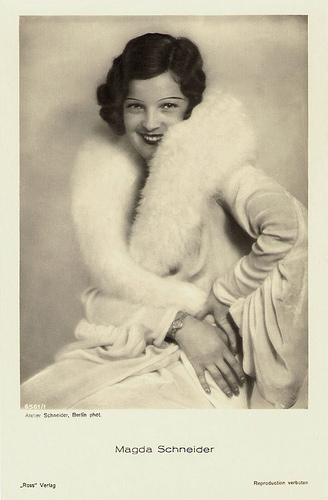
German postcard by Ross Verlag, no. 6561/1, 1931-1932. Photo: Atelier Schneider, Berlin.
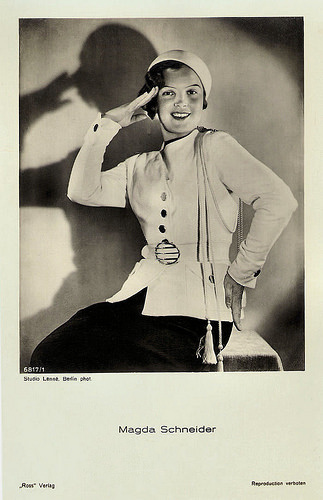
German postcard by Ross Verlag, no. 6817/1, 1931-1932. Photo: Studio Lenné, Berlin.
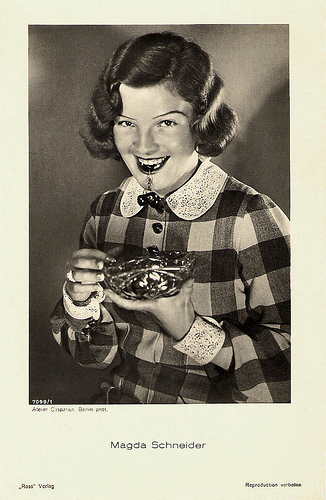
German postcard by Ross Verlag, no. 7099/1, 1932-1933. Photo: Atelier Casparius, Berlin.
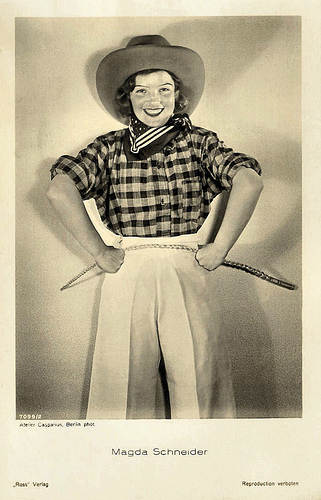
German postcard by Ross Verlag, no. 7099/2, 1932-1933. Photo: Atelier Casparius, Berlin.
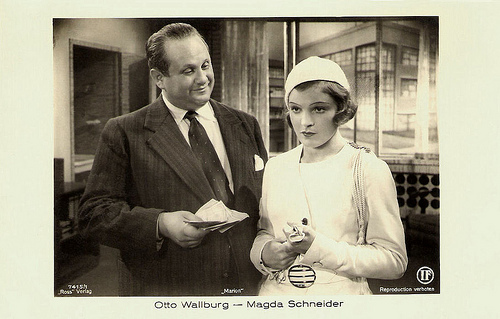
German postcard by Ross Verlag, no. 7415/1, 1932-1933. Photo: IF. Publicity still for Marion, das gehört sich nicht/Marion, That's Not Nice (E.W. Emo, 1933) with Otto Wallburg.
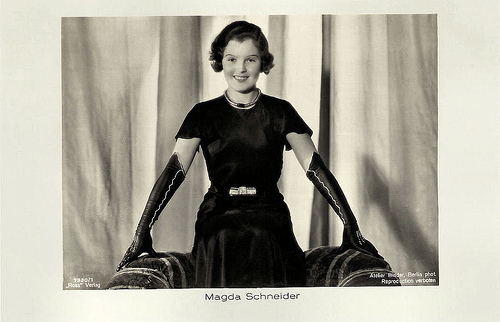
German postcard by Ross Verlag, no. 7930/1, 1932-1933. Photo: Atelier Binder, Berlin.
Soubrette
Magdalena Schneider was born in 1909 in Augsburg, Germany. She was the daughter of a plumber, Xaverius Schneider and his wife Maria Meier-Hörmann.
After visiting a Catholic girl’s school Magda studied stenography and office management at a business school and worked as a steno typist for a grain merchant. In her leisure time she studied singing at the Leopold-Mozart-Konservatorium Augsburg and followed ballet classes at the Stadtheater of her native town.
As a soubrette she made her debut in the operetta Die Fledermaus (The Bat) and played several parts in comedies in the Stadttheater of Augsburg and later also in the Staatstheater am Gärtnerplatz in München (Munich). There she was discovered by director Ernst Marischka, who invited her to work for the Theater an der Wien.
In 1930 she made her first film appearance in Boykott/Boycott (Robert Land, 1930) with Lil Dagover . Two years later she launched her film career after a film test at the Ufa studio.
She could be seen singing and dancing in such films as Zwei in einem Auto/Two in a Car (Joe May, 1932) with Kurt Gerron, Das Testament des Cornelius Gulden/The Testament of Cornelius Gulden (E.W. Emo, 1932) with Georg Alexander and Theo Lingen , Das Lied einer Nacht/Tell Me Tonight (Anatole Litvak, 1932) at the side of the star tenor Jan Kiepura , and eventually the poetic masterpiece Liebelei/Flirtation (Max Ophüls, 1933) co-starring Paul Hörbiger .
Liebelei, based on a play by Arthur Schnitzler, was one of her best films in which she could unfold her whole acting talent. 25 years later, her role in Liebelei was played by her daughter, Romy Schneider , in the film Christine (Pierre Gaspard-Huit, 1958).
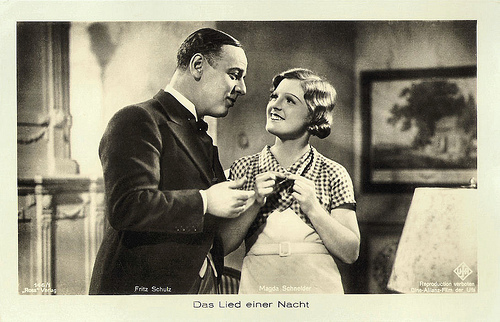
German postcard by Ross Verlag, no. 146/1. Photo: Cine-Allianz-Film der Ufa. Publicity still of Fritz Schulz and Magda Schneider in Das Lied einer Nacht/The Song of Night (Anatole Litvak, 1932).
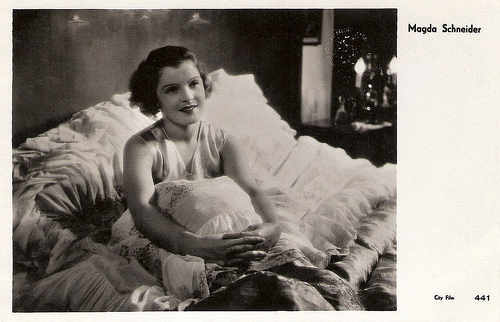
Dutch postcard by JosPe, no. 441. Sent by mail in 1933. Photo: City Film.
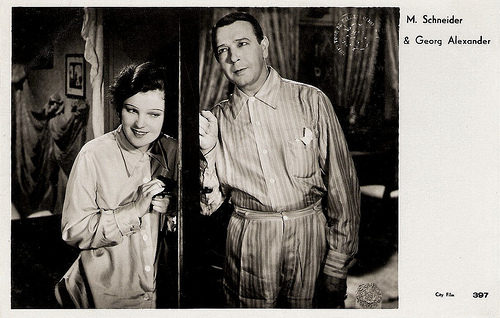
Dutch postcard by JosPe, no. 397. Photo: City Film. Publicity still for Ein bißchen Liebe für Dich/A Bit of Love (Max Neufeld, 1932) with Georg Alexander .
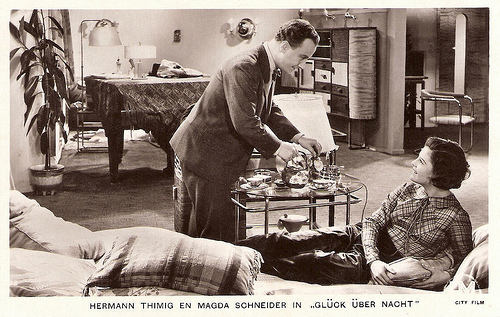
Dutch Postcard for Glück über Nacht/Happiness Over Night (Max Neufeld, 1932) with Hermann Thimig . Photo: City-Film. Notice the modern furniture & set design.
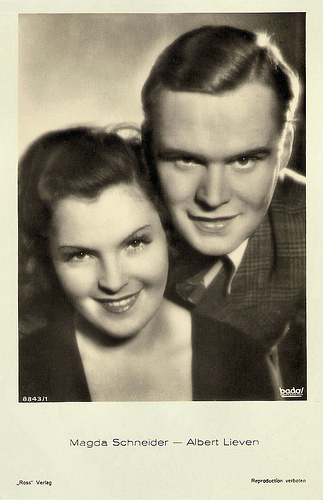
German postcard by Ross Verlag, no. 8843/1, 1934-1935. Photo: Badal Filmproduktion. Publicity still for Fräulein Liselott/Miss Liselott (Johannes Guter, 1934) with Albert Lieven .
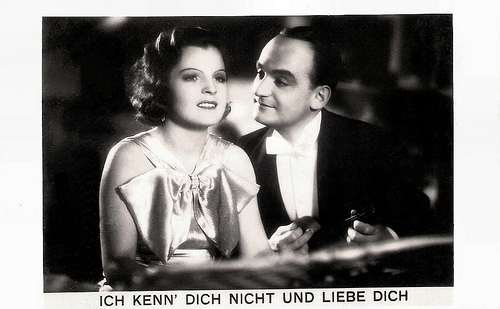
British postcard. Photo: publicity still for Ich Kenn Dich Nicht Und Liebe Dich/I Don't Know You, But I Love You (Géza von Bolváry, 1934) with Willi Forst .
Wolf Albach-Retty
During the production of the film Kind, ich freu mich auf dein Kommen/Child, I please me about your arrival (Kurt Gerron, 1933), Magda Schneider met her first husband, actor Wolf Albach-Retty .
They appeared in eight films together, including G'schichten aus dem Wienerwald/Tales from Vienna Woods (Georg Jacoby, 1934), and Rendezvous in Wien/Rendezvous in Vienna (Victor Janson, 1936).
The couple married in 1937 and would have two children, Rosemarie Magdalena, called Romy (1938-1982), and Wolfgang Dieter (1941), later a surgeon. The couple divorced in 1945 (some sources say 1946, others 1949).
Other films in which Magda appeared during the 1930s and 1940s were Eva (Johannes Riemann, 1935) with Heinz Rühmann , Frauenliebe – Frauenleid/Woman’s Love – Woman’s Sorrow (Augusto Genina, 1937) with Iván Petrovich , and Liebeskomödie/Love’s Comedy (Theo Lingen, 1942).
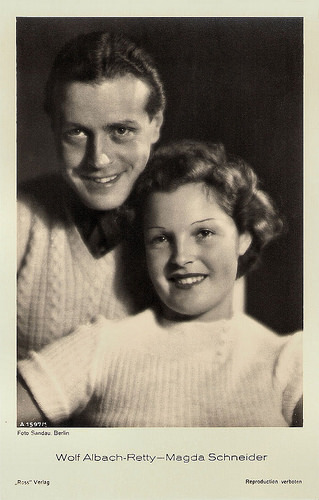
German postcard by Ross Verlag, no. A 1597/1, 1937-1938. Photo: Sandau, Berlin. With Wolf Albach-Retty .
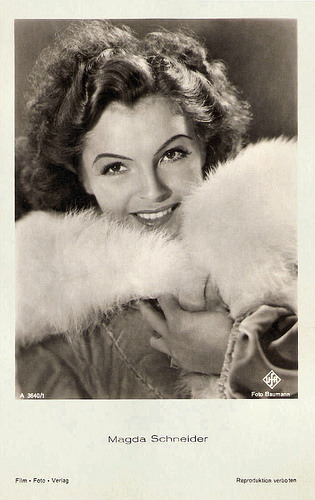
German postcard by Film-Foto-Verlag, no. A 3640/1, 1941-1944. Photo: Baumann / Ufa.
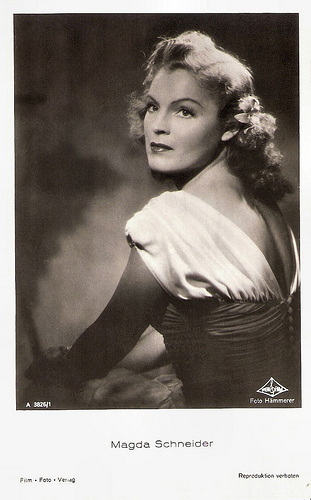
German postcard by Film-Foto-Verlag, no. A 3826/1, 1941-1944. Photo: Hämmerer / Wien Film. From Tatiana.
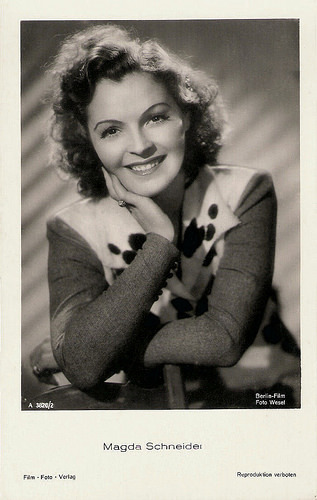
German postcard by Film-Foto-Verlag, no. A 3826/2, 1941-1944. Photo: Wesel / Berlin-Film.
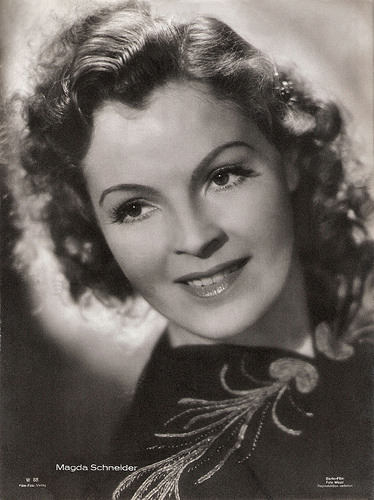
German postcard by Film-Foto-Verlag, no. W 88. Photo: Berlin Film / Wesel.
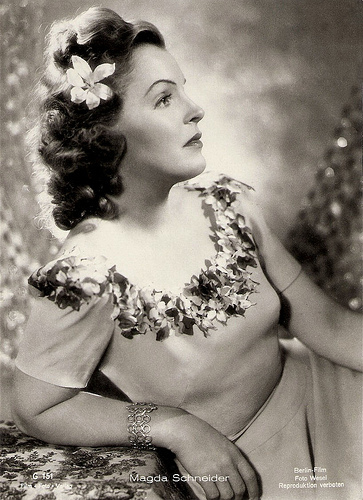
German postcard by Film-Foto-Verlag, no. G 151, 1941-1944. Photo: Wesel / Berlin-Film.
Ambitious Mother
After the Second World War, Magda Schneider found that film offers were scarce, and she mainly appeared in guest roles on stage.
The first post-war film in which she was seen was Ein Mann gehört ins Haus/A man belongs in the house (Hubert Marischka, 1948), that was already filmed in 1945.
In the 1950s, she got more film offers, but she decided to focus herself on the film career of her daughter Romy Schneider . Mother and daughter appeared together in Romy's film debut Wenn der weiße Flieder wieder blüht/When the White Lilacs Bloom Again (Hans Deppe, 1953), Mädchenjahre einer Königin/The Story of Vickie (Ernst Marischka, 1954), Die Deutschmeister/A March for the Emperor (Ernst Marischka, 1955), Robinson soll nicht sterben/The Legend of Robinson Crusoe (Josef von Báky, 1956), and Die Halbzarte/Eva (Rolf Thiele, 1958).
Best known of course is the Sissi Trilogy (Ernst Marischka, 1955-1957), based on the life of Elisabeth of Bavaria. Romy Schneider starred in the title role and Magda Schneider played the role of her mother, Princess Ludovika of Bavaria.
In 1953 Magda married Hans Herbert Blatzheim, a Cologne restaurant owner, who died in 1968. Her last appearance for the cameras was in the TV series Drei Frauen im Haus/Three Women in the House (1968) and the sequel Vier Frauen im Haus/Four Women in the House (1969).
In 1982, Magda married cinematographer Horst Fehlhaber. That same year she was awarded the Filmband in Gold. In the last years of her life Magda Schneider had to bear the tragic deaths of her grandson David in 1981 and of her daughter Romy in 1982.
Magda Schneider passed away in 1996 in Berchtesgaden, Germany. She was 87.
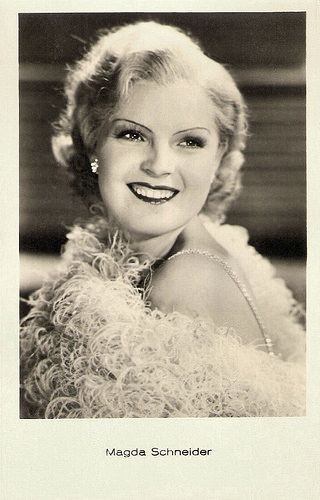
Lithuanian postcard by Izd. IRA, Riga.
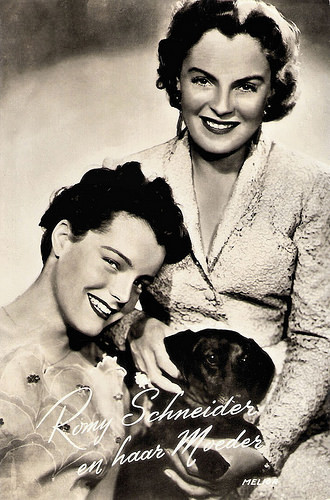
Dutch postcard. Photo: Melior. Sent by mail in 1957. Photo: publicity still for Wenn der weiße Flieder wieder blüht/When the White Lilacs Bloom Again (Hans Deppe, 1953) with Romy Schneider .
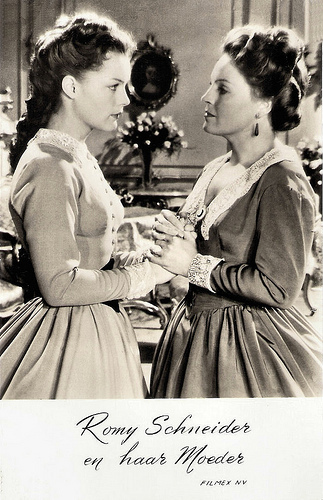
Dutch postcard by Takken, no. 3092. Photo: Filmex NV. Publicity still for Sissi - Die junge Kaiserin/Sissi: The Young Empress (Ernst Marischka, 1956) with Romy Schneider .
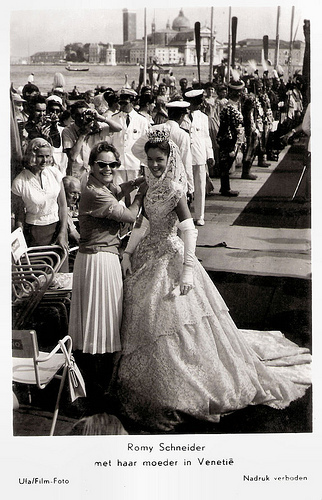
Dutch postcard by Gebr. Spanjersberg. Photo: Ufa/Film-Foto. The photo was made during the shooting of Sissi - Schicksalsjahre einer Kaiserin/Sissi: The Fateful Years of an Empress (Ernst Marischka, 1957) with Romy Schneider .
Final scene of Liebelei (Max Ophüls, 1933). Source: BD130.
German trailer for Sissi - Die junge Kaiserin (Ernst Marischka, 1956). Source: UweundPiaFan (YouTube).
Sources: Thomas Staedeli (Cyranos), Stephanie D'heil (Steffi-Line - German), Wikipedia, Filmportal.de (German), (IMDb) and .

German postcard by Ross Verlag, no. 6561/1, 1931-1932. Photo: Atelier Schneider, Berlin.

German postcard by Ross Verlag, no. 6817/1, 1931-1932. Photo: Studio Lenné, Berlin.

German postcard by Ross Verlag, no. 7099/1, 1932-1933. Photo: Atelier Casparius, Berlin.

German postcard by Ross Verlag, no. 7099/2, 1932-1933. Photo: Atelier Casparius, Berlin.

German postcard by Ross Verlag, no. 7415/1, 1932-1933. Photo: IF. Publicity still for Marion, das gehört sich nicht/Marion, That's Not Nice (E.W. Emo, 1933) with Otto Wallburg.

German postcard by Ross Verlag, no. 7930/1, 1932-1933. Photo: Atelier Binder, Berlin.
Soubrette
Magdalena Schneider was born in 1909 in Augsburg, Germany. She was the daughter of a plumber, Xaverius Schneider and his wife Maria Meier-Hörmann.
After visiting a Catholic girl’s school Magda studied stenography and office management at a business school and worked as a steno typist for a grain merchant. In her leisure time she studied singing at the Leopold-Mozart-Konservatorium Augsburg and followed ballet classes at the Stadtheater of her native town.
As a soubrette she made her debut in the operetta Die Fledermaus (The Bat) and played several parts in comedies in the Stadttheater of Augsburg and later also in the Staatstheater am Gärtnerplatz in München (Munich). There she was discovered by director Ernst Marischka, who invited her to work for the Theater an der Wien.
In 1930 she made her first film appearance in Boykott/Boycott (Robert Land, 1930) with Lil Dagover . Two years later she launched her film career after a film test at the Ufa studio.
She could be seen singing and dancing in such films as Zwei in einem Auto/Two in a Car (Joe May, 1932) with Kurt Gerron, Das Testament des Cornelius Gulden/The Testament of Cornelius Gulden (E.W. Emo, 1932) with Georg Alexander and Theo Lingen , Das Lied einer Nacht/Tell Me Tonight (Anatole Litvak, 1932) at the side of the star tenor Jan Kiepura , and eventually the poetic masterpiece Liebelei/Flirtation (Max Ophüls, 1933) co-starring Paul Hörbiger .
Liebelei, based on a play by Arthur Schnitzler, was one of her best films in which she could unfold her whole acting talent. 25 years later, her role in Liebelei was played by her daughter, Romy Schneider , in the film Christine (Pierre Gaspard-Huit, 1958).

German postcard by Ross Verlag, no. 146/1. Photo: Cine-Allianz-Film der Ufa. Publicity still of Fritz Schulz and Magda Schneider in Das Lied einer Nacht/The Song of Night (Anatole Litvak, 1932).

Dutch postcard by JosPe, no. 441. Sent by mail in 1933. Photo: City Film.

Dutch postcard by JosPe, no. 397. Photo: City Film. Publicity still for Ein bißchen Liebe für Dich/A Bit of Love (Max Neufeld, 1932) with Georg Alexander .

Dutch Postcard for Glück über Nacht/Happiness Over Night (Max Neufeld, 1932) with Hermann Thimig . Photo: City-Film. Notice the modern furniture & set design.

German postcard by Ross Verlag, no. 8843/1, 1934-1935. Photo: Badal Filmproduktion. Publicity still for Fräulein Liselott/Miss Liselott (Johannes Guter, 1934) with Albert Lieven .

British postcard. Photo: publicity still for Ich Kenn Dich Nicht Und Liebe Dich/I Don't Know You, But I Love You (Géza von Bolváry, 1934) with Willi Forst .
Wolf Albach-Retty
During the production of the film Kind, ich freu mich auf dein Kommen/Child, I please me about your arrival (Kurt Gerron, 1933), Magda Schneider met her first husband, actor Wolf Albach-Retty .
They appeared in eight films together, including G'schichten aus dem Wienerwald/Tales from Vienna Woods (Georg Jacoby, 1934), and Rendezvous in Wien/Rendezvous in Vienna (Victor Janson, 1936).
The couple married in 1937 and would have two children, Rosemarie Magdalena, called Romy (1938-1982), and Wolfgang Dieter (1941), later a surgeon. The couple divorced in 1945 (some sources say 1946, others 1949).
Other films in which Magda appeared during the 1930s and 1940s were Eva (Johannes Riemann, 1935) with Heinz Rühmann , Frauenliebe – Frauenleid/Woman’s Love – Woman’s Sorrow (Augusto Genina, 1937) with Iván Petrovich , and Liebeskomödie/Love’s Comedy (Theo Lingen, 1942).

German postcard by Ross Verlag, no. A 1597/1, 1937-1938. Photo: Sandau, Berlin. With Wolf Albach-Retty .

German postcard by Film-Foto-Verlag, no. A 3640/1, 1941-1944. Photo: Baumann / Ufa.

German postcard by Film-Foto-Verlag, no. A 3826/1, 1941-1944. Photo: Hämmerer / Wien Film. From Tatiana.

German postcard by Film-Foto-Verlag, no. A 3826/2, 1941-1944. Photo: Wesel / Berlin-Film.

German postcard by Film-Foto-Verlag, no. W 88. Photo: Berlin Film / Wesel.

German postcard by Film-Foto-Verlag, no. G 151, 1941-1944. Photo: Wesel / Berlin-Film.
Ambitious Mother
After the Second World War, Magda Schneider found that film offers were scarce, and she mainly appeared in guest roles on stage.
The first post-war film in which she was seen was Ein Mann gehört ins Haus/A man belongs in the house (Hubert Marischka, 1948), that was already filmed in 1945.
In the 1950s, she got more film offers, but she decided to focus herself on the film career of her daughter Romy Schneider . Mother and daughter appeared together in Romy's film debut Wenn der weiße Flieder wieder blüht/When the White Lilacs Bloom Again (Hans Deppe, 1953), Mädchenjahre einer Königin/The Story of Vickie (Ernst Marischka, 1954), Die Deutschmeister/A March for the Emperor (Ernst Marischka, 1955), Robinson soll nicht sterben/The Legend of Robinson Crusoe (Josef von Báky, 1956), and Die Halbzarte/Eva (Rolf Thiele, 1958).
Best known of course is the Sissi Trilogy (Ernst Marischka, 1955-1957), based on the life of Elisabeth of Bavaria. Romy Schneider starred in the title role and Magda Schneider played the role of her mother, Princess Ludovika of Bavaria.
In 1953 Magda married Hans Herbert Blatzheim, a Cologne restaurant owner, who died in 1968. Her last appearance for the cameras was in the TV series Drei Frauen im Haus/Three Women in the House (1968) and the sequel Vier Frauen im Haus/Four Women in the House (1969).
In 1982, Magda married cinematographer Horst Fehlhaber. That same year she was awarded the Filmband in Gold. In the last years of her life Magda Schneider had to bear the tragic deaths of her grandson David in 1981 and of her daughter Romy in 1982.
Magda Schneider passed away in 1996 in Berchtesgaden, Germany. She was 87.

Lithuanian postcard by Izd. IRA, Riga.

Dutch postcard. Photo: Melior. Sent by mail in 1957. Photo: publicity still for Wenn der weiße Flieder wieder blüht/When the White Lilacs Bloom Again (Hans Deppe, 1953) with Romy Schneider .

Dutch postcard by Takken, no. 3092. Photo: Filmex NV. Publicity still for Sissi - Die junge Kaiserin/Sissi: The Young Empress (Ernst Marischka, 1956) with Romy Schneider .

Dutch postcard by Gebr. Spanjersberg. Photo: Ufa/Film-Foto. The photo was made during the shooting of Sissi - Schicksalsjahre einer Kaiserin/Sissi: The Fateful Years of an Empress (Ernst Marischka, 1957) with Romy Schneider .
Final scene of Liebelei (Max Ophüls, 1933). Source: BD130.
German trailer for Sissi - Die junge Kaiserin (Ernst Marischka, 1956). Source: UweundPiaFan (YouTube).
Sources: Thomas Staedeli (Cyranos), Stephanie D'heil (Steffi-Line - German), Wikipedia, Filmportal.de (German), (IMDb) and .
Published on September 18, 2017 22:00
September 17, 2017
Jean Toulout
Jean Toulout (1887-1962) was a French stage and screen actor, director and scriptwriter. He was married to the actress Yvette Andreyor between 1917 and 1926. From 1913 on, he had an intense career in the French silent cinema.
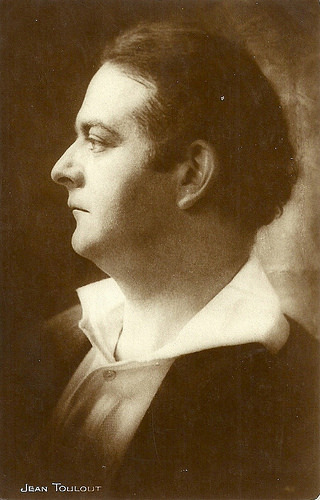
French postcard by Editions-Cinémagazine.
A jealous, evil husband
Jean Joseph Charles Toulout was born in Paris in 1887. This biography is largely based on Toulout’s filmography while no real bio has been published online about him. According to Wikipedia , Toulout started to act on stage around 1907, when he played in the Victor Hugo play Marion Delorme at the Comédie Française.
One year after, he was acting at the Théàtre des Arts, so if he ever was a member of the Comédie Française, then it was not for long. In 1911 he travelled around with Firmin Gémier ’s wandering stage company, but around 1913 he settled in Paris playing in André Antoine’s 1913 stage production of Paul Lindau’s The Prosecutor Hallers.
In 1912, Toulout debuted in the French cinema. Soon, his film career would become much more intense than his stage career. All-in all he would act in some 100 films within four decades.
Toulout started his screen career in short films by Abel Gance for Gance’s company Le film français. These included Il y a des pieds au plafond/There are feet on the ceiling, Le Nègre blanc/The White Negro, La Digue/The Dyke, Le Masque d’horreur/The Mask of Horror, all made in 1912. Soon, he also played various parts for Gaumont, Pathé and smaller companies. These films included La Maison des lions/The House of the Lions (Louis Feuillade, 1912), L’Homme qui assassina/The man who assassinated (Henri Andréani, 1913) and Les Enfants d'Édouard/The Children of Édouard (Henri Andréani, 1914).
In L’homme qui assassina, he is the evil, adulterous Lord Falkland [!], who presses his equally adulterous but goodhearted wife (Mlle Michelle) to either say goodbye to her child or publicly confess her sin, but her lover ( Firmin Gémier ) kills the husband and is even acquitted by the local Turkish commissionary (Adolphe Candé), who is very understanding in these matters.
Toulout didn’t act on screen in 1915, possibly because he was in the army during the First World War. From later 1916, he was back on track in several Gaumont films by Louis Feuillade and others. When he played in L’Autre/The Other (Louis Feuillade, 1917), he met the actress Yvette Andreyor , famous for her parts in Feuillade’s serials Fantomas and Judex. They married in 1917. Toulout and Andreyor would perform together in various films until their divorce in 1926.
Toulout was the evil antagonist of Emmy Lynn in La Dixième Symphonie/The Tenth Symphony (Abel Gance, 1918), blackmailing her for having accidentally killed his sister. She risks to wreck her new marriage with a composer ( Séverin-Mars ) but also the life of the composer’s daughter (Elizabeth Nizan). Luckily for the others he doesn’t kill them, only himself. As Wikipedia writes, “Gance's mastery of lighting, composition and editing was accompanied by a range of literary and artistic references which some critics found pretentious and alienating.”
He would be reunited with Emmy Lynn in La faute d’Odette Marchal/The fault of Odette Maréchal (Henri Roussel, 1920), and also - again as a jealous, evil husband - with Séverin-Mars in Jacques Landauze (1920) by André Hugon. With Hugon, Toulout would do several films in the 1920s and 1930s: including Le Roi de Camargue/The King of Camargue (1921), La Rue du pavé d'amour/The Pavement of Love (1923), and the first French sound film, Les Trois masques/The Three Masks (1929), shot at the London Elstree studios in only 15 days.
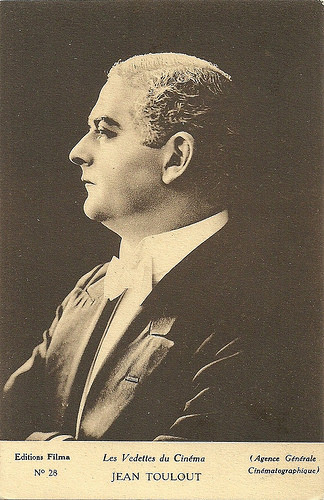
French postcard in the series Les Vedettes du Cinéma by Editions Filma, no. 28. Photo: Agence Générale Cinématographique.
A night in a haunted house
Jean Toulout also acted in films by Pierre Bressol, such as Le Mystère de la villa Mortain/The mystery of Villa Mortain (1919), and La Mission du docteur Klivers/The Mission of Doctor Klivers (1919), by Jacques Robert, Henri Fescourt, Armand du Plessis, and by Germaine Dulac, such as La fète espagnole/Spanish Fiesta (1920), and La belle dame sans-merci/The beautiful lady without mercy (1920). In La belle dame sans-merci he is a local count who finds a playful femme fatale he brought home is wrecking his whole family.
In Chantelouve (Georges Monca, 1921), he was once more the jealous husband who threatens to kill his wife ( Yvette Andreyor ). In La conquête des Gaules (Yan B. Dyl, Marcel Yonnet, 1923) he is a film director who tries to film Julius Caesar's conquest of Gaul (modern France and Belgium) with only modest means. In Le Crime de Monique/The Crime of Monique (Robert Péguy, 1923) Yvette Andreyor is accused of killing her brutal violent husband (Toulout, of course).
Toulout also acted in Abel Gance ’s hilarious comedy Au secours!/Help!(1924), starring Max Linder as a man who takes a bet to stay a night in a haunted house. When Max Linder returned to France after working in the US, he bet his friend Abel Gance - known for making big spectacles - that he couldn't make a film in less than three days. Gance accepted the bet, and this film is the result.
Toulout masterfully performed the persistent commissioner Javert in Les Misérables (Henri Fescourt, 1925), opposite Gabriel Gabrio as Jean Valjean. When a restored version was shown at the Giornate del Cinema Muto festival in Pordenone in October 2015, Peter Walsh wrote on his blog Burnt Retina : “ Gabriel Gabrio as Jean Valjean was a towering presence on screen, and his redemptive arc, and gradual aging were shown in a convincing way. Jean Toulout as Javert was also superb, at times overpowered by some of the mightiest brows and mutton chops I’ve seen in a long time. The climax of his personal crisis, and collapse of his moral world was incredibly striking, with extreme close-ups capturing a bristling performance.”
After smaller parts as in Antoinette Sabrier (Germaine Dulac, 1927), in which Toulout would be paired with Gabrio again, Toulout left the set in 1928 and returned to the stage for Le Carnaval de l'amour at the Théâtre de la Porte-Saint-Martin.
In 1929, however, Toulout was back on the screen as Mr de Villefort in the late silent film Monte Christo (Henri Fescourt, 1929) – the last big silent French production. He also appeared in the first French sound film Les Trois masques/The Three Masks (André Hugon, 1930) as a Corsican whose son (François Rozet) makes a girl (Renée Heribel) pregnant, after which her brothers take revenge during the carnival.
Toulout had the lead in the Henry Bataille adaptation La Tendresse/Tenderness (André Hugon, 1930) as a famous, older academic who discovers his much younger wife ( Marcelle Chantal ) isn’t as much in love with him as he is with her. When he gravely falls ill he however discovers she still gave the best of her life to him.
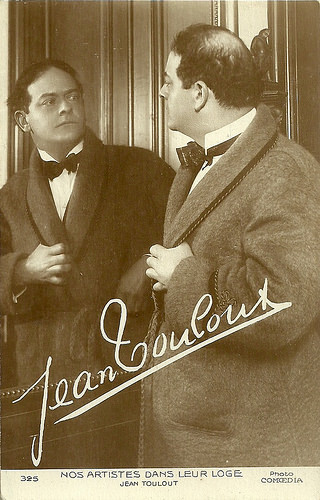
French postcard in the series Nos artistes dans leur loge, no. 325. Photo: Comoedia.
Fathers, judges, doctors, officers, and aristocrats
In 1930, Jean Toulout also tried his luck in film direction. Together with Joe Francis, he directed Le Tampon du Capiston (Joe Francis, Jean Toulout, 1930), a comical operetta film on an old spinster (Hélène Hallier), a captain’s sister, who wants to marry the captain’s aide ( Rellys ) who presumably has inherited a fortune.
In the same year, Toulout also wrote the scripts for two other films, both directed by André Hugon: La Femme et le Rossignol/Nightingale Girl (1930) and Lévy & Cie (1930), the first film of a series of four featuring Salomon and Moïse Lévy. In 1931 Toulout also scripted Moritz macht sein Glück, a German film by Dutch director Jaap Speijer.
The collaboration with Hugon continued when Toulout scripted and starred in Le Marchand de sable (André Hugon, 1931), while he had a supporting part in Hugon’s La Croix du Sud (André Hugon, 1931). The collaboration with Hugon would last till well into the mid-1940s with Le Faiseur (1936), Monsieur Bégonia (1937), La Rue sans joie (1938), Le Héros de la Marne (1938), La Sévillane (1943), and Le Chant de l'exilé (1943).
All through the 1930s Toulout had a steady, intense career as actor, but in 1934 he also directed his second film, La Reine du Biarritz, in which he himself had only a small part. Alice Field played Elenita de Sierra Mirador, who is the toast of Biarritz. For her, a young groom leaves his wife, and a forty-year-old inflamed suddenly deceives his young wife. But Elenita watched by her mother resigns herself to becoming honest and returns to her husband.
Otherwise Toulout had mostly supporting parts, as in Le petit roi/The Little King (1933) by Julien Duvivier, Fédora (Louis Gasnier, 1934), Les Nuits moscovites/Moscow Nights (Alexis Granowsky, 1934), and Le Bonheur/Happiness (Marcel L’Herbier, 1934). He played the jealous, shooting husband again in Le Vertige/Vertigo (Paul Schiller, 1935), again opposite Alice Field .
Toulout was the judge who forces Henri Garat and Lilian Harvey to marry on the spot in Les Gais lurons (Jacques Natanson, Paul Martin), the French version of Martin’s Glückskinder/Lucky Kids (1936). He is also the prosecutor in La Danseuse rouge/The Red Dancer (Jean-Paul Paulin, 1937), a courtroom drama starring Vera Korène , inspired by Mata Hari’s trial.
Toulout continued to act minor film parts in the late 1930s, during the war years and the late 1940s. Continuously, he played fathers, judges, doctors, officers, aristocrats. But he didn’t have major parts anymore. Memorable were his roles in Édouard et Caroline (Jacques Becker, 1951), starring Daniel Gélin and Anne Vernon, and – again, as a judge - in Obsession (Jean Delannoy, 1952) with Michèle Morgan and Raf Vallone .
Toulout also worked as voice actor in France. He dubbed Donald Crisp in How Green Was My Valley (John Ford, 1941, released in France in 1946), and Nigel Bruce in Limelight (Charles Chaplin, 1952). In the late 1950s, Toulout also acted on television.
Jean Toulout died in Paris in 1962. He was 75.
Sources: Peter Walsh (Burnt Retina), CinéArtistes (French), Wikipedia (English, French and Italian), and .

French postcard by Editions-Cinémagazine.
A jealous, evil husband
Jean Joseph Charles Toulout was born in Paris in 1887. This biography is largely based on Toulout’s filmography while no real bio has been published online about him. According to Wikipedia , Toulout started to act on stage around 1907, when he played in the Victor Hugo play Marion Delorme at the Comédie Française.
One year after, he was acting at the Théàtre des Arts, so if he ever was a member of the Comédie Française, then it was not for long. In 1911 he travelled around with Firmin Gémier ’s wandering stage company, but around 1913 he settled in Paris playing in André Antoine’s 1913 stage production of Paul Lindau’s The Prosecutor Hallers.
In 1912, Toulout debuted in the French cinema. Soon, his film career would become much more intense than his stage career. All-in all he would act in some 100 films within four decades.
Toulout started his screen career in short films by Abel Gance for Gance’s company Le film français. These included Il y a des pieds au plafond/There are feet on the ceiling, Le Nègre blanc/The White Negro, La Digue/The Dyke, Le Masque d’horreur/The Mask of Horror, all made in 1912. Soon, he also played various parts for Gaumont, Pathé and smaller companies. These films included La Maison des lions/The House of the Lions (Louis Feuillade, 1912), L’Homme qui assassina/The man who assassinated (Henri Andréani, 1913) and Les Enfants d'Édouard/The Children of Édouard (Henri Andréani, 1914).
In L’homme qui assassina, he is the evil, adulterous Lord Falkland [!], who presses his equally adulterous but goodhearted wife (Mlle Michelle) to either say goodbye to her child or publicly confess her sin, but her lover ( Firmin Gémier ) kills the husband and is even acquitted by the local Turkish commissionary (Adolphe Candé), who is very understanding in these matters.
Toulout didn’t act on screen in 1915, possibly because he was in the army during the First World War. From later 1916, he was back on track in several Gaumont films by Louis Feuillade and others. When he played in L’Autre/The Other (Louis Feuillade, 1917), he met the actress Yvette Andreyor , famous for her parts in Feuillade’s serials Fantomas and Judex. They married in 1917. Toulout and Andreyor would perform together in various films until their divorce in 1926.
Toulout was the evil antagonist of Emmy Lynn in La Dixième Symphonie/The Tenth Symphony (Abel Gance, 1918), blackmailing her for having accidentally killed his sister. She risks to wreck her new marriage with a composer ( Séverin-Mars ) but also the life of the composer’s daughter (Elizabeth Nizan). Luckily for the others he doesn’t kill them, only himself. As Wikipedia writes, “Gance's mastery of lighting, composition and editing was accompanied by a range of literary and artistic references which some critics found pretentious and alienating.”
He would be reunited with Emmy Lynn in La faute d’Odette Marchal/The fault of Odette Maréchal (Henri Roussel, 1920), and also - again as a jealous, evil husband - with Séverin-Mars in Jacques Landauze (1920) by André Hugon. With Hugon, Toulout would do several films in the 1920s and 1930s: including Le Roi de Camargue/The King of Camargue (1921), La Rue du pavé d'amour/The Pavement of Love (1923), and the first French sound film, Les Trois masques/The Three Masks (1929), shot at the London Elstree studios in only 15 days.

French postcard in the series Les Vedettes du Cinéma by Editions Filma, no. 28. Photo: Agence Générale Cinématographique.
A night in a haunted house
Jean Toulout also acted in films by Pierre Bressol, such as Le Mystère de la villa Mortain/The mystery of Villa Mortain (1919), and La Mission du docteur Klivers/The Mission of Doctor Klivers (1919), by Jacques Robert, Henri Fescourt, Armand du Plessis, and by Germaine Dulac, such as La fète espagnole/Spanish Fiesta (1920), and La belle dame sans-merci/The beautiful lady without mercy (1920). In La belle dame sans-merci he is a local count who finds a playful femme fatale he brought home is wrecking his whole family.
In Chantelouve (Georges Monca, 1921), he was once more the jealous husband who threatens to kill his wife ( Yvette Andreyor ). In La conquête des Gaules (Yan B. Dyl, Marcel Yonnet, 1923) he is a film director who tries to film Julius Caesar's conquest of Gaul (modern France and Belgium) with only modest means. In Le Crime de Monique/The Crime of Monique (Robert Péguy, 1923) Yvette Andreyor is accused of killing her brutal violent husband (Toulout, of course).
Toulout also acted in Abel Gance ’s hilarious comedy Au secours!/Help!(1924), starring Max Linder as a man who takes a bet to stay a night in a haunted house. When Max Linder returned to France after working in the US, he bet his friend Abel Gance - known for making big spectacles - that he couldn't make a film in less than three days. Gance accepted the bet, and this film is the result.
Toulout masterfully performed the persistent commissioner Javert in Les Misérables (Henri Fescourt, 1925), opposite Gabriel Gabrio as Jean Valjean. When a restored version was shown at the Giornate del Cinema Muto festival in Pordenone in October 2015, Peter Walsh wrote on his blog Burnt Retina : “ Gabriel Gabrio as Jean Valjean was a towering presence on screen, and his redemptive arc, and gradual aging were shown in a convincing way. Jean Toulout as Javert was also superb, at times overpowered by some of the mightiest brows and mutton chops I’ve seen in a long time. The climax of his personal crisis, and collapse of his moral world was incredibly striking, with extreme close-ups capturing a bristling performance.”
After smaller parts as in Antoinette Sabrier (Germaine Dulac, 1927), in which Toulout would be paired with Gabrio again, Toulout left the set in 1928 and returned to the stage for Le Carnaval de l'amour at the Théâtre de la Porte-Saint-Martin.
In 1929, however, Toulout was back on the screen as Mr de Villefort in the late silent film Monte Christo (Henri Fescourt, 1929) – the last big silent French production. He also appeared in the first French sound film Les Trois masques/The Three Masks (André Hugon, 1930) as a Corsican whose son (François Rozet) makes a girl (Renée Heribel) pregnant, after which her brothers take revenge during the carnival.
Toulout had the lead in the Henry Bataille adaptation La Tendresse/Tenderness (André Hugon, 1930) as a famous, older academic who discovers his much younger wife ( Marcelle Chantal ) isn’t as much in love with him as he is with her. When he gravely falls ill he however discovers she still gave the best of her life to him.

French postcard in the series Nos artistes dans leur loge, no. 325. Photo: Comoedia.
Fathers, judges, doctors, officers, and aristocrats
In 1930, Jean Toulout also tried his luck in film direction. Together with Joe Francis, he directed Le Tampon du Capiston (Joe Francis, Jean Toulout, 1930), a comical operetta film on an old spinster (Hélène Hallier), a captain’s sister, who wants to marry the captain’s aide ( Rellys ) who presumably has inherited a fortune.
In the same year, Toulout also wrote the scripts for two other films, both directed by André Hugon: La Femme et le Rossignol/Nightingale Girl (1930) and Lévy & Cie (1930), the first film of a series of four featuring Salomon and Moïse Lévy. In 1931 Toulout also scripted Moritz macht sein Glück, a German film by Dutch director Jaap Speijer.
The collaboration with Hugon continued when Toulout scripted and starred in Le Marchand de sable (André Hugon, 1931), while he had a supporting part in Hugon’s La Croix du Sud (André Hugon, 1931). The collaboration with Hugon would last till well into the mid-1940s with Le Faiseur (1936), Monsieur Bégonia (1937), La Rue sans joie (1938), Le Héros de la Marne (1938), La Sévillane (1943), and Le Chant de l'exilé (1943).
All through the 1930s Toulout had a steady, intense career as actor, but in 1934 he also directed his second film, La Reine du Biarritz, in which he himself had only a small part. Alice Field played Elenita de Sierra Mirador, who is the toast of Biarritz. For her, a young groom leaves his wife, and a forty-year-old inflamed suddenly deceives his young wife. But Elenita watched by her mother resigns herself to becoming honest and returns to her husband.
Otherwise Toulout had mostly supporting parts, as in Le petit roi/The Little King (1933) by Julien Duvivier, Fédora (Louis Gasnier, 1934), Les Nuits moscovites/Moscow Nights (Alexis Granowsky, 1934), and Le Bonheur/Happiness (Marcel L’Herbier, 1934). He played the jealous, shooting husband again in Le Vertige/Vertigo (Paul Schiller, 1935), again opposite Alice Field .
Toulout was the judge who forces Henri Garat and Lilian Harvey to marry on the spot in Les Gais lurons (Jacques Natanson, Paul Martin), the French version of Martin’s Glückskinder/Lucky Kids (1936). He is also the prosecutor in La Danseuse rouge/The Red Dancer (Jean-Paul Paulin, 1937), a courtroom drama starring Vera Korène , inspired by Mata Hari’s trial.
Toulout continued to act minor film parts in the late 1930s, during the war years and the late 1940s. Continuously, he played fathers, judges, doctors, officers, aristocrats. But he didn’t have major parts anymore. Memorable were his roles in Édouard et Caroline (Jacques Becker, 1951), starring Daniel Gélin and Anne Vernon, and – again, as a judge - in Obsession (Jean Delannoy, 1952) with Michèle Morgan and Raf Vallone .
Toulout also worked as voice actor in France. He dubbed Donald Crisp in How Green Was My Valley (John Ford, 1941, released in France in 1946), and Nigel Bruce in Limelight (Charles Chaplin, 1952). In the late 1950s, Toulout also acted on television.
Jean Toulout died in Paris in 1962. He was 75.
Sources: Peter Walsh (Burnt Retina), CinéArtistes (French), Wikipedia (English, French and Italian), and .
Published on September 17, 2017 22:00
September 16, 2017
Conny Froboess
German singer Cornelia - Conny - Froboess (1943) was an immensely popular teen idol in the late 1950s and early 1960s. In the 1970s she transformed into a respected stage actress.
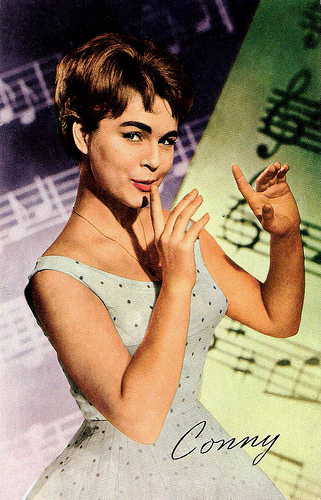
Dutch postcard by Uitg. 't Sticht, Utrecht, no. 116. Photo: Hafbofilm, Amsterdam.
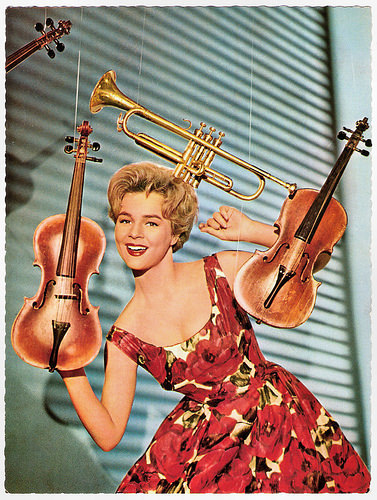
Big Dutch postcard by Gebr. Spanjersberg N.V., Rotterdam.
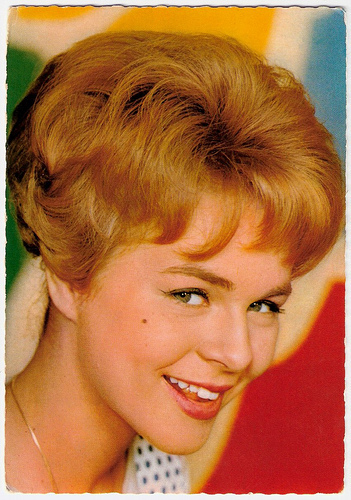
Dutch postcard by Gebr. Spanjersberg N.V., Rotterdam. Sent by mail in 1962.
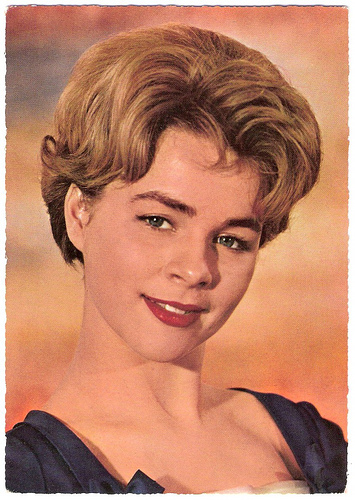
German postcard by Krüger, no. 902/72. Photo: Winkler / Sascha-Film / Constantin / Werner Press. Publicity card for Electrola.
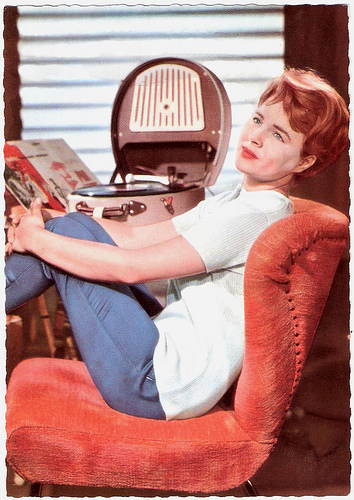
German postcard by Ufa, no. CK-298. Retail price: 30 Pfg. Photo: Arthur Grimm / UFA.
Germany's first post-war child star
Cornelia 'Conny' Froboess was born in Wriezen a.d. Oder, in Brandenburg, eastern Germany, in 1943. Her mother Margaretha was sent there when her homeplace Berlin was bombed during the war.
Her father was the composer Gerhard Froboess. In 1951, his composition Pack die Badehose ein (Pack Your Swimsuit, 1951) made his 7-year-old daughter Germany's first post-war child star.
Pack die Badehose ein is a cheery tune about a group of children going to swim at the Wannsee near Berlin on a hot summer's day. The song was originally composed for the Schöneberger Sängerknaben, but their manager refused the song. And so ‘Die kleine Cornelia’ (Little Cornelia) performed the song for the RIAS-radio show Mach mit live at the Berlin Titania-Palast. Her stage debut was a huge success.
The same year Die kleine Cornelia made her (uncredited) first film appearance in Sündige Grenze/Illegal Border (Robert A. Stemmle, 1951) with Dieter Borsche, about a band of juvenile smugglers. In the next years many other films followed, such as Lass die Sonne Wieder Scheinen/Let the Sun Shine (Hubert Marischka, 1955) with Hans Holt .
She released more singles over the next couple of years and as she grew Die kleine Cornelia recorded as Conny and then as Conny Froboess.
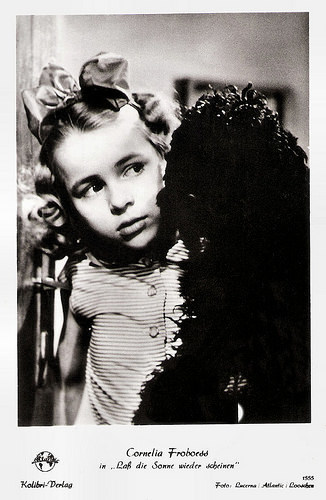
West-German postcard by Kolibri-Verlag, no. 1555. Photo: Lucerna / Atlantic / Looschen. Publicity still for Lass die Sonne wieder scheinen/Let the Sun Shine (Hubert Marischka, 1955).
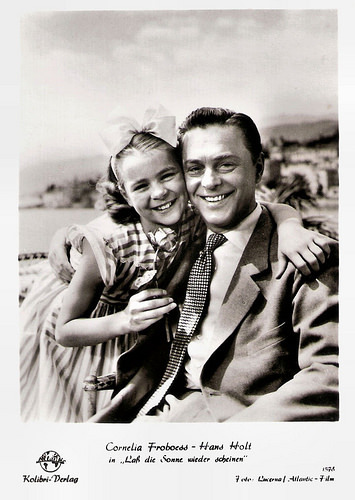
German postcard by Kolibri-Verlag, no. 1578. Photo: Lucerna / Atlantic-Film. Publicity still for Lass die Sonne Wieder Scheinen/Let the Sun Shine (Hubert Marischka, 1955) with Hans Holt .
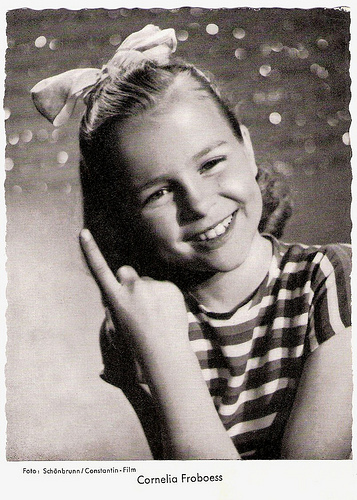
German postcard by WS-Druck, Wanne-Eickel. Photo: Schönbrunn / Constantin-Film.
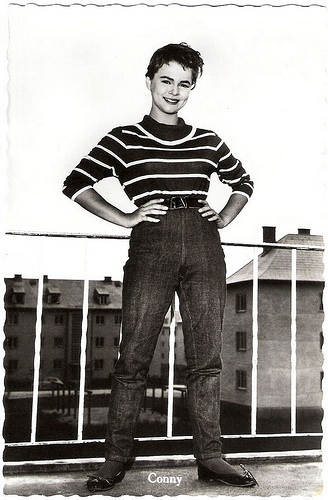
Dutch Postcard by N.V. v.h. Weenenk & Snel, Baarn, no. 1060.
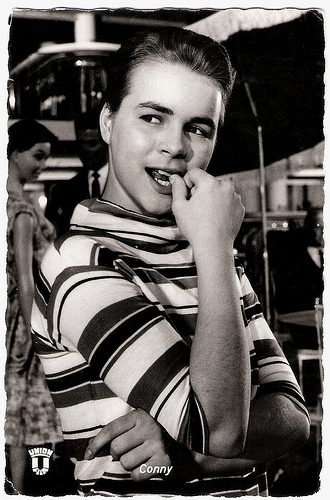
German postcard by Kolibri-Verlag G.m.b.H, Minden/Westf., no. 511. Photo: H.P. / Union / Ewald. Publicity still for Hula Hopp, Conny (Heinz Paul, 1959).
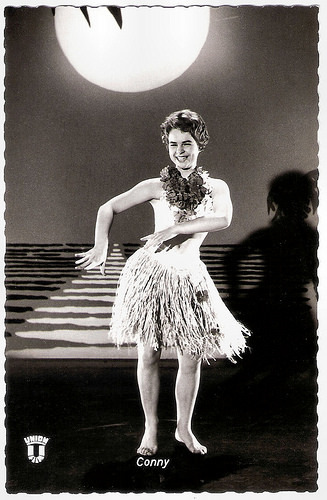
German postcard by Kolibri-Verlag G.m.b.H., Minden-Westf., no 557. Photo: H.P. / Union / Ewald. Publicity still for Hula-Hopp, Conny (Heinz Paul, 1959).
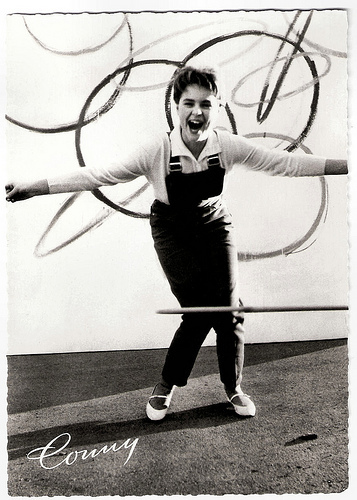
German postcard by Bartoschek-Verlag, Stuttgart Bad Canstatt, no. 1693. Photo: H.P.-Film / Union / Haenchen. Publicity still for Hula-Hopp, Conny (Heinz Paul, 1959).
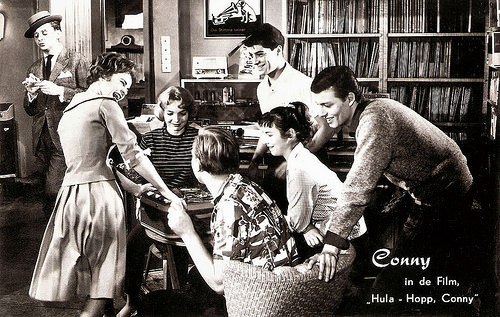
Dutch postcard. Photo: Publicity still for Hula-Hopp, Conny (Heinz Paul, 1959).
Teen Idol
In 1958, after the Rock and Roll wave had hit Germany, Cornelia Froboess recorded Paul Anka’s Diana. The song became no. 2 in the German hit parade and Cornelia became teen idol Conny. The name change signified a shift towards a more hip, Americanised image for the teenager.
Bruce Eder at AllMusic : "Froboess -- who was still a teenager and, thus, a natural fit for the new music -- began doing occasional rhythm numbers that incorporated a livelier, quasi-rock & roll beat into her music, roughly akin to what Connie Francis was doing in America and Petula Clark was doing in England and France at around the same time."
Other hits followed like I love You Baby (1958), Blue jean boy (1958), and Lady Sunshine und Mister Moon (1962). These hits cemented her position and saw the singer become an idol for German teens. Her star would rise even more with a string of popular Schlager films in which she performed her hits.
In Hula-Hopp, Conny (Heinz-Paul, 1959) with Rex Gildo, she performed songs like Holiday in Honolulu, Die Boys und Girls von heute and of course Diana. Gildo was also her co-star in Ja, so ein Mädchen mit sechzehn (Hans Grimm, 1959) in which she sang the title song and also Little Girl and Such das Glück des Lebens.
Another frequent co-star was Peter Weck. They appeared together in such films as the remake Mariandl (Werner Jacobs, 1961). Probably the best of their films together was Der Traum von Lieschen Müller/The Dream of Lieschen Mueller (Helmut Kautner, 1961), in which Sonja Ziemann played the leading role.
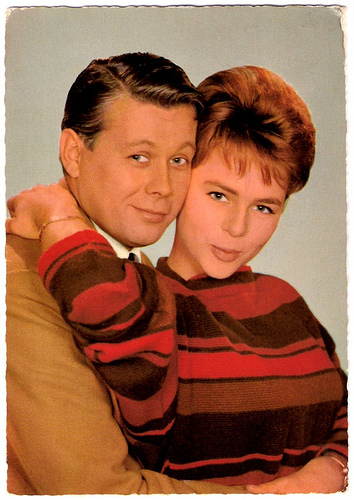
Dutch postcard. Sent by mail in 1964. Conny with Peter Weck .
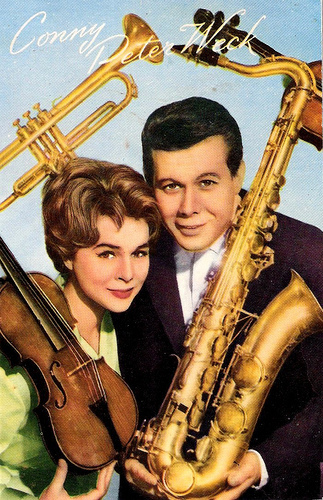
Dutch postcard. Conny with Peter Weck .
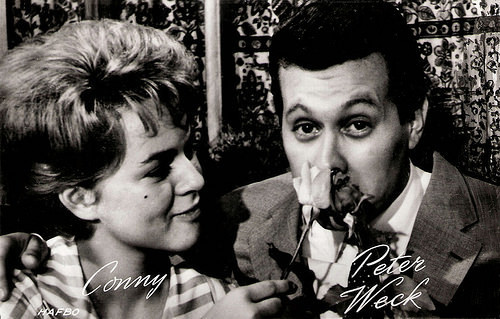
Dutch postcard by Uitgeverij Takken, Utrecht, no. AX 4899. Photo: Hafbo Film. Publicity still for Junge Leute brauchen Liebe/Young People Need Love (Géza von Cziffra, 1961) with Peter Weck .
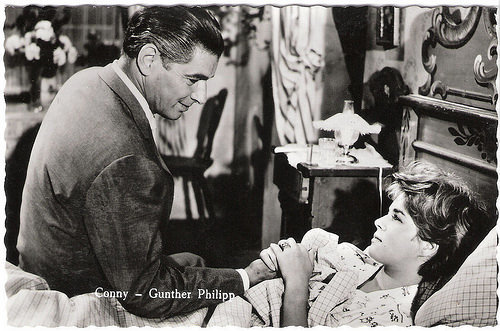
Dutch postcard by N.V. v.h. Weenenk & Snel, Baarn. Photo: publicity still for Mariandl (Werner Jacobs, 1961). The man on the postcard is not the mentioned Günther Philipp but Rudolf Prack .
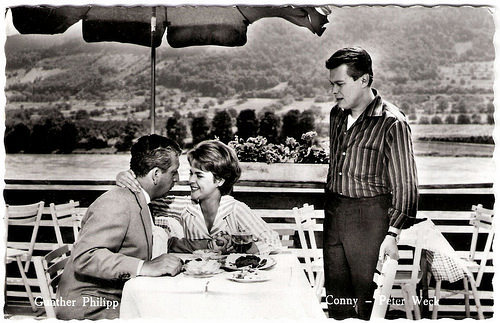
Dutch postcard by N.V. v.h. Weenenk & Snel, Baarn, no. 762. Photo: publicity still for Mariandl (Werner Jacobs, 1961) with Günther Philipp and Peter Weck .
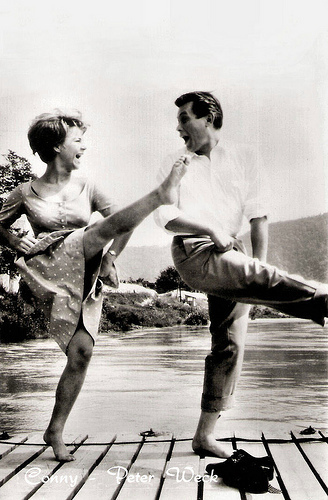
Dutch postcard by Int. Filmpers, Amsterdam, no. WPS 168. Photo: Centrafilm. Publicity still for Mariandl (Werner Jacobs, 1961).
When Conny and Peter Do It Together
In her films Conny Froboess often portrayed a spontaneous 'Berliner Göre' (Brat from Berlin) who craves for independence from her strict parents.
Her comedy with 'the German Elvis', Peter Kraus , Wenn die Conny mit dem Peter/When Conny and Peter Do It Together (Fritz Umgelter, 1958), made them 'The dream couple of the German show world'.
Their Conny und Peter machen Musik/Conny and Peter Are Making Music (Werner Jacobs, 1960) was even the biggest box office hit of that year. Jan Onderwater at IMDb : "Despite too simple story and so-so directing, a jolly and entertaining Schlager film, due to cast that makes the best of it, but it could have done with one or two Schlagers more (was Papa Froboess out of material?)."
Despite these commercial successes Conny and Peter only made these two Schlagerfilms together.
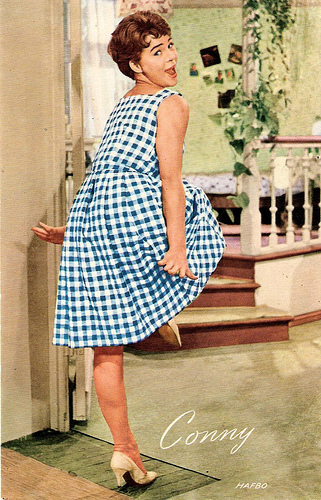
Dutch postcard. Photo: Hafbo. Publicity still for Ja, so ein Mädchen mit sechzehn/Yeah, Such A Sixteen Year Old Girl (Hans Grimm, 1959).
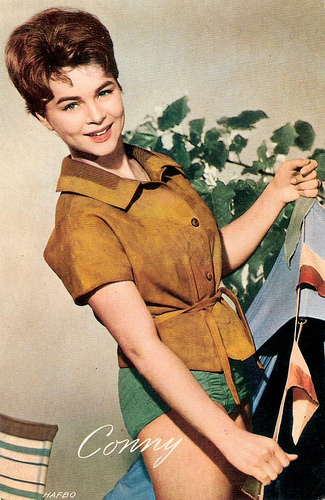
Dutch postcard by 't Sticht, Utrecht, no. 112. Photo: HAFBO. Publicity still from Conny und Peter machen Musik (Werner Jacobs, 1960).
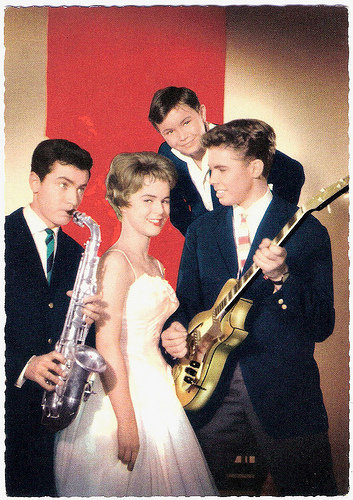
German postcard by ISV, no. E 13. Photo: Constantin / Grimm. Conny with Rex Gildo (left), Peter Krauss (right), and Rolf Pinegger.
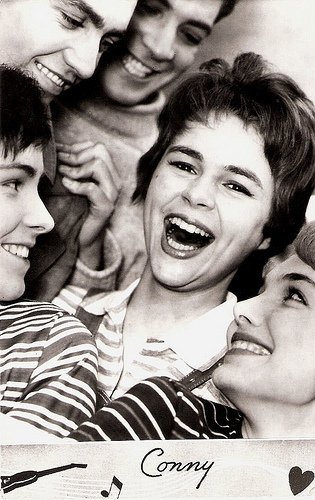
Vintage card, with far left Rex Gildo .
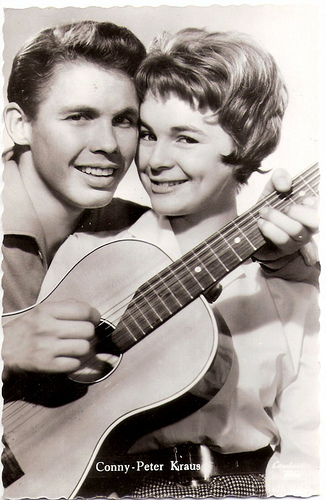
Dutch postcard, no. 761, with Peter Krauss .
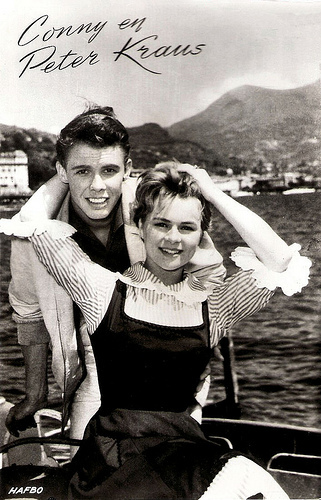
Dutch postcard by Uitg. Takken, Utrecht, no. AX 4489. Photo: Hafbo. Publicity still for Conny und Peter machen Musik (Werner Jacobs, 1960) with Peter Krauss .
The Eurovision Song Contest
In 1962 Conny Froboess' song Zwei kleine Italiener (Two Little Italians) was Germany's entry at The Eurovision Song Contest. At the 1962 Deutsche Schlager-Festpielen, the German preliminaries, she had narrowly beaten Swedish singer Siw Malmkvist into second place.
In Luxembourg at the pan-European final, Conny finished disappointingly sixth but the song became her only no. 1 hit in Germany. It stayed there for five weeks and was awarded a gold disc. Conny also recorded the song in Dutch, English and Italian. Zwei kleine Italiener – penned by Christian Bruhn and Georg Buschor – went on to sell over a million copies internationally and is considered an evergreen of German pop.
That same year she appeared in Jean Renoir's war comedy Le caporal épinglé/The Elusive Corporal (1962), starring Jean-Pierre Cassel as a corporal who during WWII tries to escape from German prison camps, sometimes making it a few yards, sometimes reaching the French border. Her role in the film was small, but the film was prestigious.
In the mid-1960s, she branched out from Schlager films to doing filmed operetta, including a version of Carl Zeller's Der Vogelhändler/The Bird Seller (Géza von Cziffra, 1962) with Peter Weck . Jan Onderwater at IMDb : "The plot of the operetta was changed to fit into 90 minutes, but maybe also for the original being unacceptably corny; but it is all to no avail. Von Cziffra directed without imagination and spirit and he is hopelessly inadequate in using the Ultrascope format. The result is a dull film."
She also made two comedies with Peter Alexander , Der Musterknabe/The model boy (Werner Jacobs, 1963) and Hilfe, meine Braut klaut/Help, My Bride Steals (Werner Jacobs, 1964) in which she played a kleptomaniac. The Beatles now topped the charts and Conny Froboess had lost her interest in music. She had been taking acting lessons since the late 1950s, and she decided to focus on acting.
Public and critical acclaim for her role in the TV film Wahn oder der Teufel in Boston/Delusion or the devil in Boston (Gerhard Klingenberg, 1965), based on a play by Lion Feuchtwanger, proved decisive. German magazine HörZu wrote surprised: "Television has won a young talented actress. Fraulein Froboess will probably have to decide now - for Conny or Cornelia."
From then on, she would strive to become a respected stage and TV actress and she would go on to portray the heroins of several classic plays. Credited as Cornelia Froboess...
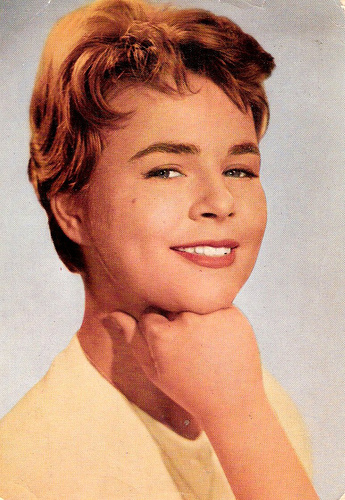
German postcard by ISV, no. H 48.
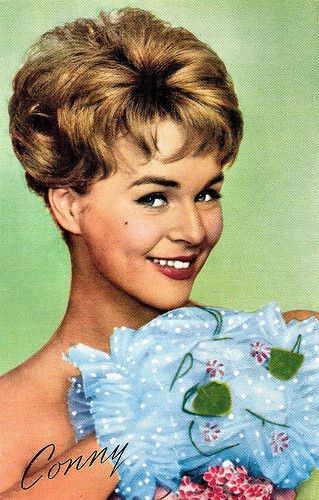
Dutch postcard by 't Sticht, Utrecht, Maxicolor no. 126. Photo: Hafbo. Publicity still for Junge Leute brauchen Liebe/Young People Need Love (Géza von Cziffra, 1961).
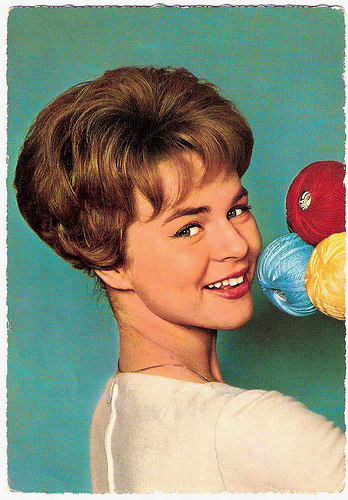
German postcard by Krüger, no. 902/97. Photo: Bavariafilm.
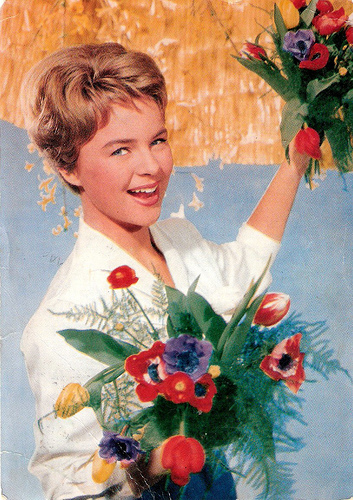
Dutch postcard by Gebr. Spanjersberg N.V., Rotterdam, no. CK 365. Ca. 1962. Photo: Ufa, Berlin.
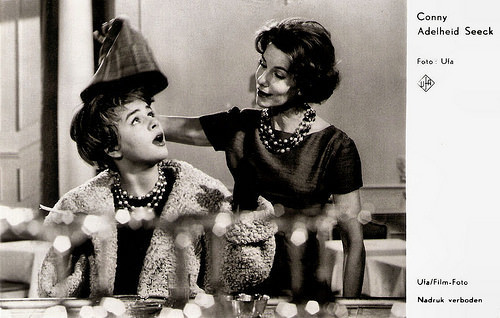
Dutch postcard. Photo: Ufa. Publicity still for Mein Mann, das Wirtschaftswunder/My husband, the economic miracle (Ulrich Erfurth, 1961) with Adelheid Seeck .
Rainer Werner Fassbinder
From 1972 to 2001 Cornelia Froboess was a permanent ensemble member at the renowned Kammerspiele in Munich, and since 2001 at the Bayerisches Staatsschauspiel. A hugely popular success was her role as Eliza Doolittle in the stage musical My Fair Lady at Munich’s Theater am Gärtnerplatz.
Froboess also worked regularly for television, but she made only a few more feature films. With director Kurt Hoffmann, she made the romantic comedy Rheinsberg (1967), based on a novel by Kurt Tucholsky. She won the Ernst Lubitsch prize for her role, and in 1968 she won a Golden Camera for the title role in the film Mathilde Möhring (Claus Peter Witt, 1968), based on a play by Theodor Fontane. A complete failure was her comedy with showmaster Rudi Carrell , Crazy - total verrückt (Franz Josef Gottlieb, 1973)
Remarkable was her role in Rainer Werner Fassbinder ’s excellent drama Die Sehnsucht der Veronika Voss/Veronika Voss (1982). It was the third and last film in the trilogy that included Die Ehe der Maria Braun/The Marriage of Maria Braun (Rainer Werner Fassbinder, 1979) and Lola (Rainer Werner Fassbinder, 1981). and was one of the last films Fassbinder made before his sudden death.
Froboess played Henriette, girlfriend of a sports journalist (Hilmar Thate) who by chance meets mysterious, former Ufa star Veronika Voss (Rosel Zech) and becomes intrigued by her. Henriette is curious about what will happen between them.
On stage, she played in 1988 Marthe Schwerdtlein in Johann Wolfgang von Goethe's Faust I, a performance that was also released as film: Faust – Vom Himmel durch die Welt zur Hölle/Faust - the film (Dieter Dorn, 1988) starring Helmut Griem . On stage, she appeared in Gotthold Ephraim Lessing's Minna von Barnhelm in 1976, and played Ellida in Henrik Ibsen's The Lady from the Sea in 1990. At the Salzburg Festival 2004, she played Mary Tyrone in Eugene O'Neill's Long Day's Journey into Night. The same year she played the title role in Bertolt Brecht's play Mutter Courage und ihre Kinder (Mother Courage and Her Children).
In the film Knockin' on Heaven's Door (Thomas Jahn, 1997), she played the mother of a man suffering of terminal cancer, played by Til Schweiger . The film was an unexpected smash hit. Later film appearances include a role as a grandmother in Villa Henriette (Peter Payer, 2004), the family film Ostwind/Stormwind (Katja von Garnier, 2013) and its sequels Ostwind 2 (Katja von Garnier, 2015) and Ostwind 3: Aufbruch nach Ora (Katja von Garnier, 2017).
She also appears regularly on TV as a guest star in such popular Krimi series as SOKO 5113 (2009), Der Alte/The Old Fox (1980-2010) and Tatort/Crime Scene (2000-2016). At the time of writing this bio, she is working on the TV comedy Ein Lächeln nachts um vier/A smile at four at night (Jan Ruzicka, 2018) with August Wittgenstein and Tilo Prückner. It shows the durability of her talent.
Since 1967 Cornelia Froboess is married to Austrian theatre director and manager Hellmuth Matiasek. They have two children, Agnes (1968) and Kaspar (1970). The family lives in Inntal near Wendelstein mountain in the Bavarian Alps in South Germany.
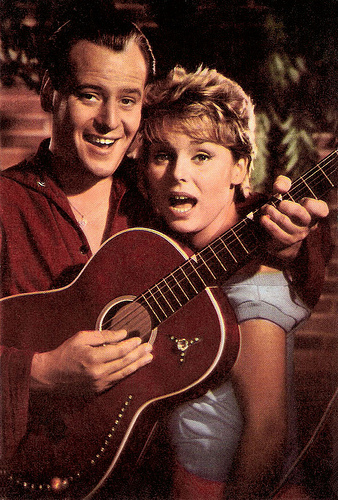
Belgian postcard by Cox, no. 25. With Fred Bertelmann . Photo: probably a publicity still for Wenn das mein großer Bruder wüßte/When my big brother knew that (Erik Ode, 1959)
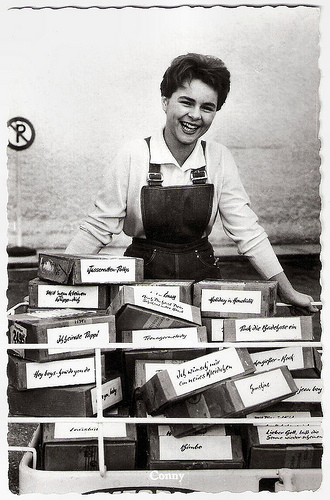
Dutch postcard.
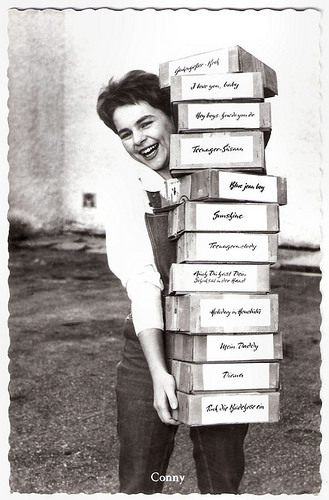
Dutch postcard by N.V. v.h. Weenenk & Snel, Baarn. Sent by mail in 1961.
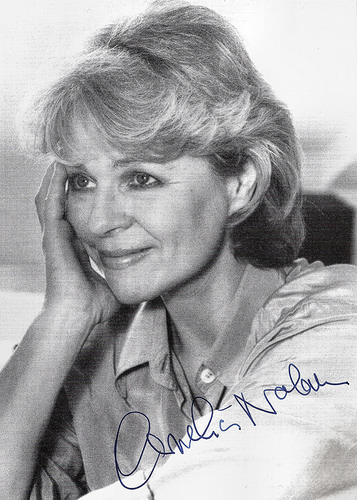
German promotion card by Electrola. Photo: Studio Berneis, München.
Cornelia Froboess sings Diana in Hula-Hopp, Conny (Heinz Paul, 1959). Source: Liebhaberaltermusik (YouTube).
Another clip of Hula-Hopp, Conny (Heinz Paul, 1959). Froboess sings Holiday in Honolulu with Rex Gildo at the piano. Source: eukryptos (YouTube).
Conny Froboess sings Wo ist der Mann? in Der Traum von Lieschen Müller/The Dream of Lieschen Muelle (Helmut Kautner, 1961). Source: scaasifun (YouTube).
Conny Froboess sings Zwei kleine Italiener (1962) in several films. Source: FRitz12345 (YouTube).
Sources: Jan Onderwater (IMDb), Bruce Eder (AllMusic), Filmportal.de, Ready steady girls, Die Krimi Home Page (German), and Wikipedia.

Dutch postcard by Uitg. 't Sticht, Utrecht, no. 116. Photo: Hafbofilm, Amsterdam.

Big Dutch postcard by Gebr. Spanjersberg N.V., Rotterdam.

Dutch postcard by Gebr. Spanjersberg N.V., Rotterdam. Sent by mail in 1962.

German postcard by Krüger, no. 902/72. Photo: Winkler / Sascha-Film / Constantin / Werner Press. Publicity card for Electrola.

German postcard by Ufa, no. CK-298. Retail price: 30 Pfg. Photo: Arthur Grimm / UFA.
Germany's first post-war child star
Cornelia 'Conny' Froboess was born in Wriezen a.d. Oder, in Brandenburg, eastern Germany, in 1943. Her mother Margaretha was sent there when her homeplace Berlin was bombed during the war.
Her father was the composer Gerhard Froboess. In 1951, his composition Pack die Badehose ein (Pack Your Swimsuit, 1951) made his 7-year-old daughter Germany's first post-war child star.
Pack die Badehose ein is a cheery tune about a group of children going to swim at the Wannsee near Berlin on a hot summer's day. The song was originally composed for the Schöneberger Sängerknaben, but their manager refused the song. And so ‘Die kleine Cornelia’ (Little Cornelia) performed the song for the RIAS-radio show Mach mit live at the Berlin Titania-Palast. Her stage debut was a huge success.
The same year Die kleine Cornelia made her (uncredited) first film appearance in Sündige Grenze/Illegal Border (Robert A. Stemmle, 1951) with Dieter Borsche, about a band of juvenile smugglers. In the next years many other films followed, such as Lass die Sonne Wieder Scheinen/Let the Sun Shine (Hubert Marischka, 1955) with Hans Holt .
She released more singles over the next couple of years and as she grew Die kleine Cornelia recorded as Conny and then as Conny Froboess.

West-German postcard by Kolibri-Verlag, no. 1555. Photo: Lucerna / Atlantic / Looschen. Publicity still for Lass die Sonne wieder scheinen/Let the Sun Shine (Hubert Marischka, 1955).

German postcard by Kolibri-Verlag, no. 1578. Photo: Lucerna / Atlantic-Film. Publicity still for Lass die Sonne Wieder Scheinen/Let the Sun Shine (Hubert Marischka, 1955) with Hans Holt .

German postcard by WS-Druck, Wanne-Eickel. Photo: Schönbrunn / Constantin-Film.

Dutch Postcard by N.V. v.h. Weenenk & Snel, Baarn, no. 1060.

German postcard by Kolibri-Verlag G.m.b.H, Minden/Westf., no. 511. Photo: H.P. / Union / Ewald. Publicity still for Hula Hopp, Conny (Heinz Paul, 1959).

German postcard by Kolibri-Verlag G.m.b.H., Minden-Westf., no 557. Photo: H.P. / Union / Ewald. Publicity still for Hula-Hopp, Conny (Heinz Paul, 1959).

German postcard by Bartoschek-Verlag, Stuttgart Bad Canstatt, no. 1693. Photo: H.P.-Film / Union / Haenchen. Publicity still for Hula-Hopp, Conny (Heinz Paul, 1959).

Dutch postcard. Photo: Publicity still for Hula-Hopp, Conny (Heinz Paul, 1959).
Teen Idol
In 1958, after the Rock and Roll wave had hit Germany, Cornelia Froboess recorded Paul Anka’s Diana. The song became no. 2 in the German hit parade and Cornelia became teen idol Conny. The name change signified a shift towards a more hip, Americanised image for the teenager.
Bruce Eder at AllMusic : "Froboess -- who was still a teenager and, thus, a natural fit for the new music -- began doing occasional rhythm numbers that incorporated a livelier, quasi-rock & roll beat into her music, roughly akin to what Connie Francis was doing in America and Petula Clark was doing in England and France at around the same time."
Other hits followed like I love You Baby (1958), Blue jean boy (1958), and Lady Sunshine und Mister Moon (1962). These hits cemented her position and saw the singer become an idol for German teens. Her star would rise even more with a string of popular Schlager films in which she performed her hits.
In Hula-Hopp, Conny (Heinz-Paul, 1959) with Rex Gildo, she performed songs like Holiday in Honolulu, Die Boys und Girls von heute and of course Diana. Gildo was also her co-star in Ja, so ein Mädchen mit sechzehn (Hans Grimm, 1959) in which she sang the title song and also Little Girl and Such das Glück des Lebens.
Another frequent co-star was Peter Weck. They appeared together in such films as the remake Mariandl (Werner Jacobs, 1961). Probably the best of their films together was Der Traum von Lieschen Müller/The Dream of Lieschen Mueller (Helmut Kautner, 1961), in which Sonja Ziemann played the leading role.

Dutch postcard. Sent by mail in 1964. Conny with Peter Weck .

Dutch postcard. Conny with Peter Weck .

Dutch postcard by Uitgeverij Takken, Utrecht, no. AX 4899. Photo: Hafbo Film. Publicity still for Junge Leute brauchen Liebe/Young People Need Love (Géza von Cziffra, 1961) with Peter Weck .

Dutch postcard by N.V. v.h. Weenenk & Snel, Baarn. Photo: publicity still for Mariandl (Werner Jacobs, 1961). The man on the postcard is not the mentioned Günther Philipp but Rudolf Prack .

Dutch postcard by N.V. v.h. Weenenk & Snel, Baarn, no. 762. Photo: publicity still for Mariandl (Werner Jacobs, 1961) with Günther Philipp and Peter Weck .

Dutch postcard by Int. Filmpers, Amsterdam, no. WPS 168. Photo: Centrafilm. Publicity still for Mariandl (Werner Jacobs, 1961).
When Conny and Peter Do It Together
In her films Conny Froboess often portrayed a spontaneous 'Berliner Göre' (Brat from Berlin) who craves for independence from her strict parents.
Her comedy with 'the German Elvis', Peter Kraus , Wenn die Conny mit dem Peter/When Conny and Peter Do It Together (Fritz Umgelter, 1958), made them 'The dream couple of the German show world'.
Their Conny und Peter machen Musik/Conny and Peter Are Making Music (Werner Jacobs, 1960) was even the biggest box office hit of that year. Jan Onderwater at IMDb : "Despite too simple story and so-so directing, a jolly and entertaining Schlager film, due to cast that makes the best of it, but it could have done with one or two Schlagers more (was Papa Froboess out of material?)."
Despite these commercial successes Conny and Peter only made these two Schlagerfilms together.

Dutch postcard. Photo: Hafbo. Publicity still for Ja, so ein Mädchen mit sechzehn/Yeah, Such A Sixteen Year Old Girl (Hans Grimm, 1959).

Dutch postcard by 't Sticht, Utrecht, no. 112. Photo: HAFBO. Publicity still from Conny und Peter machen Musik (Werner Jacobs, 1960).

German postcard by ISV, no. E 13. Photo: Constantin / Grimm. Conny with Rex Gildo (left), Peter Krauss (right), and Rolf Pinegger.

Vintage card, with far left Rex Gildo .

Dutch postcard, no. 761, with Peter Krauss .

Dutch postcard by Uitg. Takken, Utrecht, no. AX 4489. Photo: Hafbo. Publicity still for Conny und Peter machen Musik (Werner Jacobs, 1960) with Peter Krauss .
The Eurovision Song Contest
In 1962 Conny Froboess' song Zwei kleine Italiener (Two Little Italians) was Germany's entry at The Eurovision Song Contest. At the 1962 Deutsche Schlager-Festpielen, the German preliminaries, she had narrowly beaten Swedish singer Siw Malmkvist into second place.
In Luxembourg at the pan-European final, Conny finished disappointingly sixth but the song became her only no. 1 hit in Germany. It stayed there for five weeks and was awarded a gold disc. Conny also recorded the song in Dutch, English and Italian. Zwei kleine Italiener – penned by Christian Bruhn and Georg Buschor – went on to sell over a million copies internationally and is considered an evergreen of German pop.
That same year she appeared in Jean Renoir's war comedy Le caporal épinglé/The Elusive Corporal (1962), starring Jean-Pierre Cassel as a corporal who during WWII tries to escape from German prison camps, sometimes making it a few yards, sometimes reaching the French border. Her role in the film was small, but the film was prestigious.
In the mid-1960s, she branched out from Schlager films to doing filmed operetta, including a version of Carl Zeller's Der Vogelhändler/The Bird Seller (Géza von Cziffra, 1962) with Peter Weck . Jan Onderwater at IMDb : "The plot of the operetta was changed to fit into 90 minutes, but maybe also for the original being unacceptably corny; but it is all to no avail. Von Cziffra directed without imagination and spirit and he is hopelessly inadequate in using the Ultrascope format. The result is a dull film."
She also made two comedies with Peter Alexander , Der Musterknabe/The model boy (Werner Jacobs, 1963) and Hilfe, meine Braut klaut/Help, My Bride Steals (Werner Jacobs, 1964) in which she played a kleptomaniac. The Beatles now topped the charts and Conny Froboess had lost her interest in music. She had been taking acting lessons since the late 1950s, and she decided to focus on acting.
Public and critical acclaim for her role in the TV film Wahn oder der Teufel in Boston/Delusion or the devil in Boston (Gerhard Klingenberg, 1965), based on a play by Lion Feuchtwanger, proved decisive. German magazine HörZu wrote surprised: "Television has won a young talented actress. Fraulein Froboess will probably have to decide now - for Conny or Cornelia."
From then on, she would strive to become a respected stage and TV actress and she would go on to portray the heroins of several classic plays. Credited as Cornelia Froboess...

German postcard by ISV, no. H 48.

Dutch postcard by 't Sticht, Utrecht, Maxicolor no. 126. Photo: Hafbo. Publicity still for Junge Leute brauchen Liebe/Young People Need Love (Géza von Cziffra, 1961).

German postcard by Krüger, no. 902/97. Photo: Bavariafilm.

Dutch postcard by Gebr. Spanjersberg N.V., Rotterdam, no. CK 365. Ca. 1962. Photo: Ufa, Berlin.

Dutch postcard. Photo: Ufa. Publicity still for Mein Mann, das Wirtschaftswunder/My husband, the economic miracle (Ulrich Erfurth, 1961) with Adelheid Seeck .
Rainer Werner Fassbinder
From 1972 to 2001 Cornelia Froboess was a permanent ensemble member at the renowned Kammerspiele in Munich, and since 2001 at the Bayerisches Staatsschauspiel. A hugely popular success was her role as Eliza Doolittle in the stage musical My Fair Lady at Munich’s Theater am Gärtnerplatz.
Froboess also worked regularly for television, but she made only a few more feature films. With director Kurt Hoffmann, she made the romantic comedy Rheinsberg (1967), based on a novel by Kurt Tucholsky. She won the Ernst Lubitsch prize for her role, and in 1968 she won a Golden Camera for the title role in the film Mathilde Möhring (Claus Peter Witt, 1968), based on a play by Theodor Fontane. A complete failure was her comedy with showmaster Rudi Carrell , Crazy - total verrückt (Franz Josef Gottlieb, 1973)
Remarkable was her role in Rainer Werner Fassbinder ’s excellent drama Die Sehnsucht der Veronika Voss/Veronika Voss (1982). It was the third and last film in the trilogy that included Die Ehe der Maria Braun/The Marriage of Maria Braun (Rainer Werner Fassbinder, 1979) and Lola (Rainer Werner Fassbinder, 1981). and was one of the last films Fassbinder made before his sudden death.
Froboess played Henriette, girlfriend of a sports journalist (Hilmar Thate) who by chance meets mysterious, former Ufa star Veronika Voss (Rosel Zech) and becomes intrigued by her. Henriette is curious about what will happen between them.
On stage, she played in 1988 Marthe Schwerdtlein in Johann Wolfgang von Goethe's Faust I, a performance that was also released as film: Faust – Vom Himmel durch die Welt zur Hölle/Faust - the film (Dieter Dorn, 1988) starring Helmut Griem . On stage, she appeared in Gotthold Ephraim Lessing's Minna von Barnhelm in 1976, and played Ellida in Henrik Ibsen's The Lady from the Sea in 1990. At the Salzburg Festival 2004, she played Mary Tyrone in Eugene O'Neill's Long Day's Journey into Night. The same year she played the title role in Bertolt Brecht's play Mutter Courage und ihre Kinder (Mother Courage and Her Children).
In the film Knockin' on Heaven's Door (Thomas Jahn, 1997), she played the mother of a man suffering of terminal cancer, played by Til Schweiger . The film was an unexpected smash hit. Later film appearances include a role as a grandmother in Villa Henriette (Peter Payer, 2004), the family film Ostwind/Stormwind (Katja von Garnier, 2013) and its sequels Ostwind 2 (Katja von Garnier, 2015) and Ostwind 3: Aufbruch nach Ora (Katja von Garnier, 2017).
She also appears regularly on TV as a guest star in such popular Krimi series as SOKO 5113 (2009), Der Alte/The Old Fox (1980-2010) and Tatort/Crime Scene (2000-2016). At the time of writing this bio, she is working on the TV comedy Ein Lächeln nachts um vier/A smile at four at night (Jan Ruzicka, 2018) with August Wittgenstein and Tilo Prückner. It shows the durability of her talent.
Since 1967 Cornelia Froboess is married to Austrian theatre director and manager Hellmuth Matiasek. They have two children, Agnes (1968) and Kaspar (1970). The family lives in Inntal near Wendelstein mountain in the Bavarian Alps in South Germany.

Belgian postcard by Cox, no. 25. With Fred Bertelmann . Photo: probably a publicity still for Wenn das mein großer Bruder wüßte/When my big brother knew that (Erik Ode, 1959)

Dutch postcard.

Dutch postcard by N.V. v.h. Weenenk & Snel, Baarn. Sent by mail in 1961.

German promotion card by Electrola. Photo: Studio Berneis, München.
Cornelia Froboess sings Diana in Hula-Hopp, Conny (Heinz Paul, 1959). Source: Liebhaberaltermusik (YouTube).
Another clip of Hula-Hopp, Conny (Heinz Paul, 1959). Froboess sings Holiday in Honolulu with Rex Gildo at the piano. Source: eukryptos (YouTube).
Conny Froboess sings Wo ist der Mann? in Der Traum von Lieschen Müller/The Dream of Lieschen Muelle (Helmut Kautner, 1961). Source: scaasifun (YouTube).
Conny Froboess sings Zwei kleine Italiener (1962) in several films. Source: FRitz12345 (YouTube).
Sources: Jan Onderwater (IMDb), Bruce Eder (AllMusic), Filmportal.de, Ready steady girls, Die Krimi Home Page (German), and Wikipedia.
Published on September 16, 2017 22:00
September 15, 2017
Aimé Simon-Girard
French film actor and operetta singer Aimé Simon-Girard (1889-1950) mostly played in French costume films of the 1920s and 1930s. He is best known as D'Artagnan in the twelve part silent serial Les Trois Mousquetaires/The Three Musketeers (1921), based on the famous novel by Alexandre Dumas père.
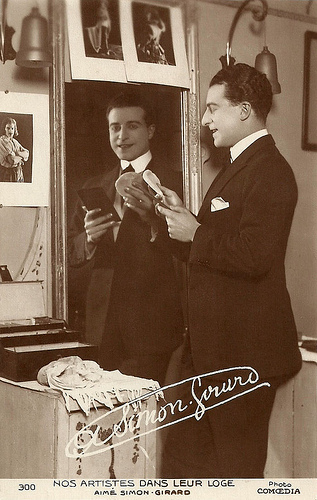
French postcard in the series Nos artistes dans leur loge, no. 300. Photo: Comoedia. The card top right on the photo is from Les Trois Mousquetaires (Henri Diamant-Berger 1921), see it also below.
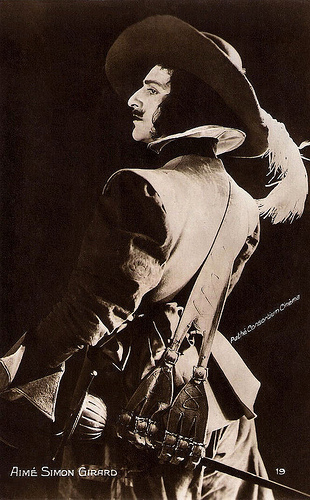
French postcard by Editions Cinémagazine no. 19. Photo: Pathé Consortium Cinéma. Aimé Simon-Girard as D'Artagnan in Les Trois Mousquetaires/The Three Musketeers (Henri Diamant-Berger, 1921).
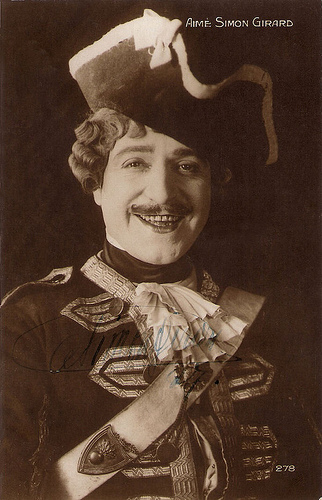
French postcard by Cinémagazine, no. 278. Photo: Aimé Simon-Girard as D'Artagnan in Les Trois Mousquetaires/The Three Musketeers (Henri Diamant-Berger, 1921).
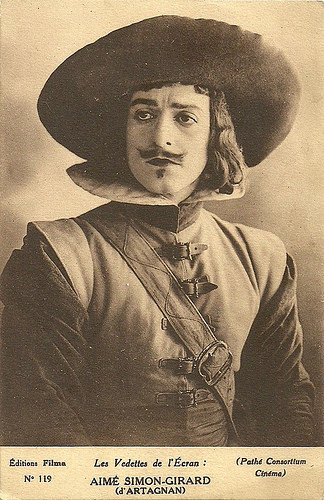
French postcard by Editions Filma in the series Les Vedettes de l'Écran, no. 119. Photo: Pathé Consortium Cinéma. Aimé Simon-Girard as D'Artagnan in Les trois mousquetaires/The Three Musketeers (Henri Diamant-Berger, 1921).
D'Artagnan
Aimé Simon-Girard was born as Aimé Max Simon in Paris in 1889 as the son of the tenor Nicholas Simon-Max and the soprano Juliette Simon-Girard. Thanks to his artistic parents he first pursued a career as operetta singer, and with success. Soon he became a star in the Parisian theatres with the name Simon-Girard.
On the eve of the First World War, he started in film, playing opposite Gabriel de Gravone in La maison du baigneur/The house of the swimmer (Adrien Caillard, 1913). The following year he met the man who would launch him into cinema stardom: Henri Diamant-Berger. They made one short film together, Loin des yeux, près du coeur/Absence makes the heart grow fonder (1914), but during the war Simon-Girard mostly continued working on stage.
In 1921, though, his old friend gave him the leading part of D'Artagnan in the twelve part silent serial Les Trois Mousquetaires/The Three Musketeers (Henri Diamant-Berger, 1921). It was not the first film adaptation of the novel by Alexandre Dumas père but a very popular one. For Simon-Girard it was his breakthrough role in the cinema. He played opposite such actors as Henri Rollan (Athos), Charles Martinelli (Porthos), Pierre de Guingand (Aramis), Claude Mérelle (Mylady de Winter), Jeanne Desclos (Anne of Austria), Édouard de Max (Richelieu) and Charles Dullin (Le Père Joseph).
Soon cinema veteran Louis Feuillade asked him for another twelve part serial: Le fils du flibustier/The Son of the Pirate (1922), with Georges Biscot , Sandra Milowanoff and a debuting Gaby Morlay .
In 1923 Simon-Girard directed a short himself, La belle Henriette/The Beautiful Henriette, with Germaine Webb. By now Simon-Girard was type-casted as a period piece actor, as in Vert galant/Courteous green (René Leprince, 1924), an eight part serial on the life of the French King Henri IV, followed by two other eight-part serials in costume: Fanfan-la-Tulipe (René Leprince, 1925) which was reshot in 1952 with Gérard Philipe , and Mylord l’arsouille/The ruffian Mylord (René Leprince, 1925). His costars in these three serials were Claude Mérelle , Joë Hamman , Claude France , Maria Dalbaicin, Pierre de Guingand and Simone Vaudry .
In the late 1920s, Aimé Simon-Girard played in La grande amie/The great friend (Max de Rieux, 1927), and in the comedy Les transatlantiques/Deckchairs (Pierre Colombier, 1928) about an American family visiting France.
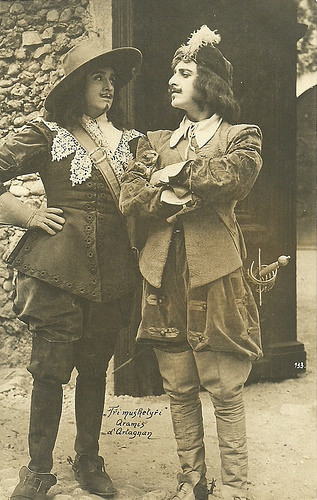
French postcard, no. 133. Pierre de Guingand as Aramis and Aimé-Simon Girard as D'Artagnan in Les trois mousquetaires/The Three Musketeers (Henri Diamant-Berger, 1921).
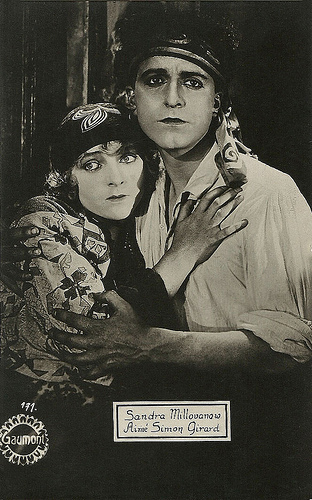
French Postcard, no. 171. Photo: Gaumont. Publicity still for Le fils du flibustier/The Son of the Pirate (Louis Feuillade, 1922) with Sandra Milowanoff . Collection: Didier Hanson.
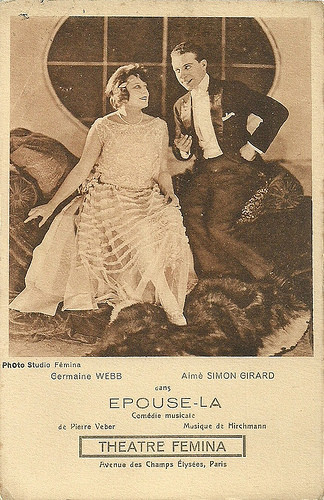
French postcard. Photo: Studio Fémina. Aimé Simon-Girard and Germaine Webb in the musical stage comedy Epouse-la by Pierre Veber, music by Hirchmann, at the Theatre Fémina, Avenue des Champs-Elysées, Paris.
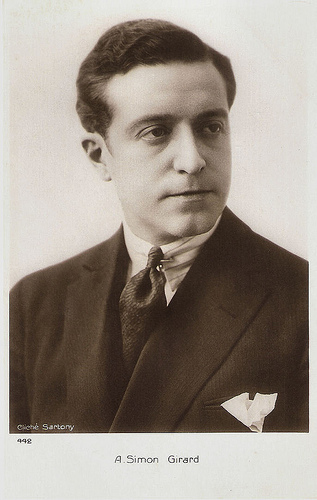
French postcard by Cinémagazine-Edition, no. 442. Photo: Sartony.
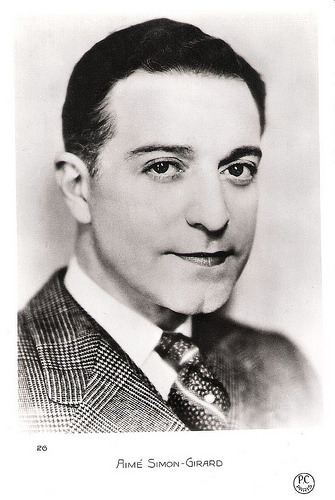
French postcard by P.C., Paris, no. 26.
Tired of Period Pieces
Because of his fine voice, the passage to sound cinema was not a real obstacle for Aimé Simon-Girard. He debuted in sound film with Les quatre vagabonds/The Four Vagabonds (1931), directed by Lupu Pick, the Rumanian master of German Kammerspielfilm. Simon-Girard wrote the French dialogue and adaptation of Les quatre vagabonds. He plays Pierre who suspects one of four young vagabonds has murdered the suitor of his beloved Marie (Simone Bourday).
Next, Simon-Girard resurrected D’Artagnan once more in the sound version of Les trois mousquetaires/The Three Musketeers (1932), again directed by Henri Diamant-Berger, but this time with Blanche Montel as Constance, Harry Baur as Tréville, Edith Meyra as Mylady de Winter, and Andrée Lafayette as Anna of Austria, the French queen.
Tired of the period pieces, Simon-Girard henceforth focused on the stage. In 1934, he also recorded songs like L’amour en fleurs (the French version of Gracie Fields ’ Love in bloom) and Cocktails pour deux (Cocktails For two), with artists such as Django Reinhardt, being part of the orchestra of Michel Warlop.
Incidentally Simon-Girard returned to the set to play a reporter in Arsène Lupin, detective (1937), which had Jules Berry in the title role, while Simon-Girard played the title role (a small one) in the Fernandel comedy François premier/Francis the First (Christian Jaque, 1937).
He also played king Henri IV twice in Les perles de la couronne/The Pearls of the Crown (Sacha Guitry, 1937) and in the comedy Alexis gentleman chauffeur (Max de Vaucorbeil, René Guissart, 1938). Simon-Girard‘s last parts were in Le cavalier noir/The black rider (Gilles Grangier. 1944) starring Georges Guétary , and the two-part film Mandrin (René Jayet, 1947), starring José Noguéro.
Aimé Simon-Girard died in Paris in 1950. All in all, he had acted in some 20 films and serials between 1921 and 1948.
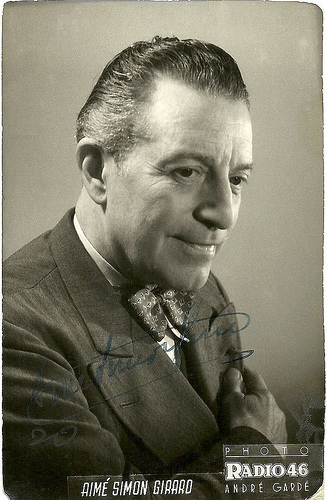
French postcard. Photo: Radio 46 / André Gardé. Collection: Didier Hanson.
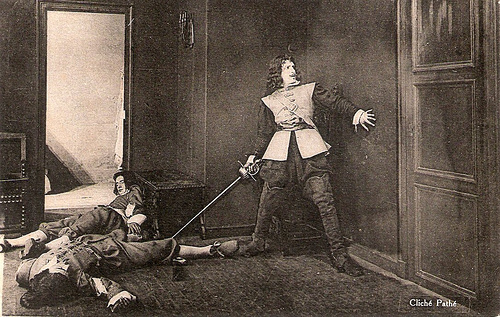
French postcard by M. Le Deley, Paris. Photo: still from Les Trois Mousquetaires (Henri Diamant Berger, 1921), based on the famous novel by Alexandre Dumas père, and produced by Pathé Consortium Cinéma.
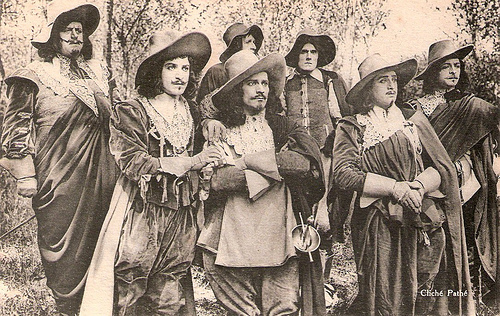
French postcard by M. Le Deley, Paris. Photo: still from Les Trois Mousquetaires (Henri Diamant Berger, 1921), based on the famous novel by Alexandre Dumas père, and produced by Pathé Consortium Cinéma.
Aimé Simon-Girard sings Cocktails Pour Deux (1934). Source: Bibi1944 (YouTube).
Sources: CineArtistes (French), Wikipedia (French and English) and .

French postcard in the series Nos artistes dans leur loge, no. 300. Photo: Comoedia. The card top right on the photo is from Les Trois Mousquetaires (Henri Diamant-Berger 1921), see it also below.

French postcard by Editions Cinémagazine no. 19. Photo: Pathé Consortium Cinéma. Aimé Simon-Girard as D'Artagnan in Les Trois Mousquetaires/The Three Musketeers (Henri Diamant-Berger, 1921).

French postcard by Cinémagazine, no. 278. Photo: Aimé Simon-Girard as D'Artagnan in Les Trois Mousquetaires/The Three Musketeers (Henri Diamant-Berger, 1921).

French postcard by Editions Filma in the series Les Vedettes de l'Écran, no. 119. Photo: Pathé Consortium Cinéma. Aimé Simon-Girard as D'Artagnan in Les trois mousquetaires/The Three Musketeers (Henri Diamant-Berger, 1921).
D'Artagnan
Aimé Simon-Girard was born as Aimé Max Simon in Paris in 1889 as the son of the tenor Nicholas Simon-Max and the soprano Juliette Simon-Girard. Thanks to his artistic parents he first pursued a career as operetta singer, and with success. Soon he became a star in the Parisian theatres with the name Simon-Girard.
On the eve of the First World War, he started in film, playing opposite Gabriel de Gravone in La maison du baigneur/The house of the swimmer (Adrien Caillard, 1913). The following year he met the man who would launch him into cinema stardom: Henri Diamant-Berger. They made one short film together, Loin des yeux, près du coeur/Absence makes the heart grow fonder (1914), but during the war Simon-Girard mostly continued working on stage.
In 1921, though, his old friend gave him the leading part of D'Artagnan in the twelve part silent serial Les Trois Mousquetaires/The Three Musketeers (Henri Diamant-Berger, 1921). It was not the first film adaptation of the novel by Alexandre Dumas père but a very popular one. For Simon-Girard it was his breakthrough role in the cinema. He played opposite such actors as Henri Rollan (Athos), Charles Martinelli (Porthos), Pierre de Guingand (Aramis), Claude Mérelle (Mylady de Winter), Jeanne Desclos (Anne of Austria), Édouard de Max (Richelieu) and Charles Dullin (Le Père Joseph).
Soon cinema veteran Louis Feuillade asked him for another twelve part serial: Le fils du flibustier/The Son of the Pirate (1922), with Georges Biscot , Sandra Milowanoff and a debuting Gaby Morlay .
In 1923 Simon-Girard directed a short himself, La belle Henriette/The Beautiful Henriette, with Germaine Webb. By now Simon-Girard was type-casted as a period piece actor, as in Vert galant/Courteous green (René Leprince, 1924), an eight part serial on the life of the French King Henri IV, followed by two other eight-part serials in costume: Fanfan-la-Tulipe (René Leprince, 1925) which was reshot in 1952 with Gérard Philipe , and Mylord l’arsouille/The ruffian Mylord (René Leprince, 1925). His costars in these three serials were Claude Mérelle , Joë Hamman , Claude France , Maria Dalbaicin, Pierre de Guingand and Simone Vaudry .
In the late 1920s, Aimé Simon-Girard played in La grande amie/The great friend (Max de Rieux, 1927), and in the comedy Les transatlantiques/Deckchairs (Pierre Colombier, 1928) about an American family visiting France.

French postcard, no. 133. Pierre de Guingand as Aramis and Aimé-Simon Girard as D'Artagnan in Les trois mousquetaires/The Three Musketeers (Henri Diamant-Berger, 1921).

French Postcard, no. 171. Photo: Gaumont. Publicity still for Le fils du flibustier/The Son of the Pirate (Louis Feuillade, 1922) with Sandra Milowanoff . Collection: Didier Hanson.

French postcard. Photo: Studio Fémina. Aimé Simon-Girard and Germaine Webb in the musical stage comedy Epouse-la by Pierre Veber, music by Hirchmann, at the Theatre Fémina, Avenue des Champs-Elysées, Paris.

French postcard by Cinémagazine-Edition, no. 442. Photo: Sartony.

French postcard by P.C., Paris, no. 26.
Tired of Period Pieces
Because of his fine voice, the passage to sound cinema was not a real obstacle for Aimé Simon-Girard. He debuted in sound film with Les quatre vagabonds/The Four Vagabonds (1931), directed by Lupu Pick, the Rumanian master of German Kammerspielfilm. Simon-Girard wrote the French dialogue and adaptation of Les quatre vagabonds. He plays Pierre who suspects one of four young vagabonds has murdered the suitor of his beloved Marie (Simone Bourday).
Next, Simon-Girard resurrected D’Artagnan once more in the sound version of Les trois mousquetaires/The Three Musketeers (1932), again directed by Henri Diamant-Berger, but this time with Blanche Montel as Constance, Harry Baur as Tréville, Edith Meyra as Mylady de Winter, and Andrée Lafayette as Anna of Austria, the French queen.
Tired of the period pieces, Simon-Girard henceforth focused on the stage. In 1934, he also recorded songs like L’amour en fleurs (the French version of Gracie Fields ’ Love in bloom) and Cocktails pour deux (Cocktails For two), with artists such as Django Reinhardt, being part of the orchestra of Michel Warlop.
Incidentally Simon-Girard returned to the set to play a reporter in Arsène Lupin, detective (1937), which had Jules Berry in the title role, while Simon-Girard played the title role (a small one) in the Fernandel comedy François premier/Francis the First (Christian Jaque, 1937).
He also played king Henri IV twice in Les perles de la couronne/The Pearls of the Crown (Sacha Guitry, 1937) and in the comedy Alexis gentleman chauffeur (Max de Vaucorbeil, René Guissart, 1938). Simon-Girard‘s last parts were in Le cavalier noir/The black rider (Gilles Grangier. 1944) starring Georges Guétary , and the two-part film Mandrin (René Jayet, 1947), starring José Noguéro.
Aimé Simon-Girard died in Paris in 1950. All in all, he had acted in some 20 films and serials between 1921 and 1948.

French postcard. Photo: Radio 46 / André Gardé. Collection: Didier Hanson.

French postcard by M. Le Deley, Paris. Photo: still from Les Trois Mousquetaires (Henri Diamant Berger, 1921), based on the famous novel by Alexandre Dumas père, and produced by Pathé Consortium Cinéma.

French postcard by M. Le Deley, Paris. Photo: still from Les Trois Mousquetaires (Henri Diamant Berger, 1921), based on the famous novel by Alexandre Dumas père, and produced by Pathé Consortium Cinéma.
Aimé Simon-Girard sings Cocktails Pour Deux (1934). Source: Bibi1944 (YouTube).
Sources: CineArtistes (French), Wikipedia (French and English) and .
Published on September 15, 2017 22:00
Paul van Yperen's Blog
- Paul van Yperen's profile
- 13 followers
Paul van Yperen isn't a Goodreads Author
(yet),
but they
do have a blog,
so here are some recent posts imported from
their feed.



